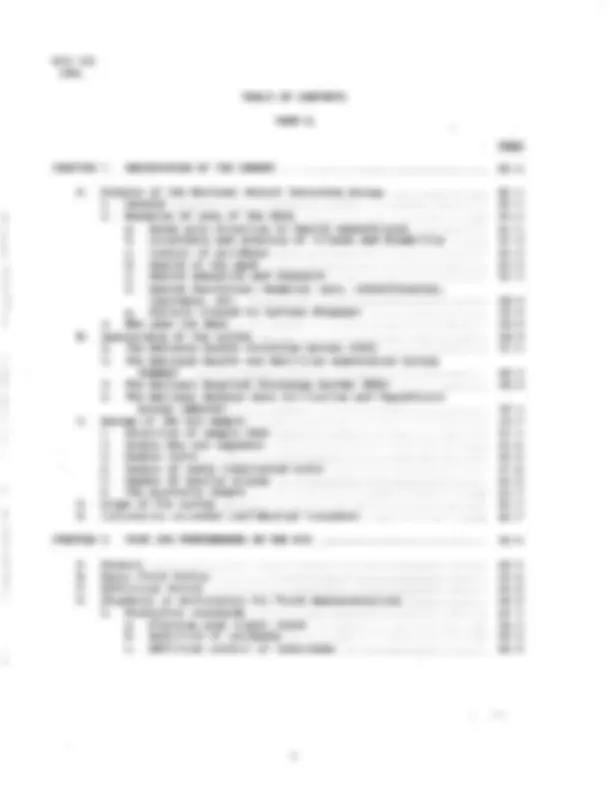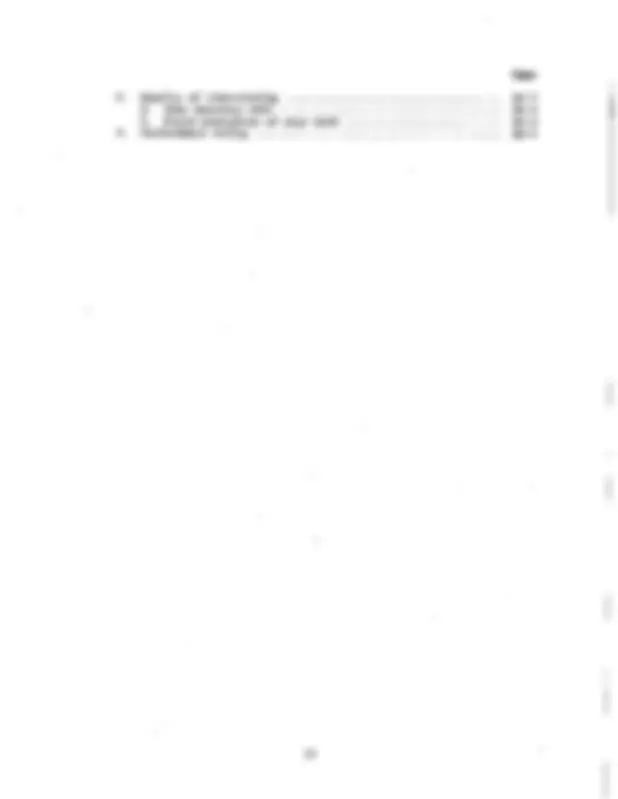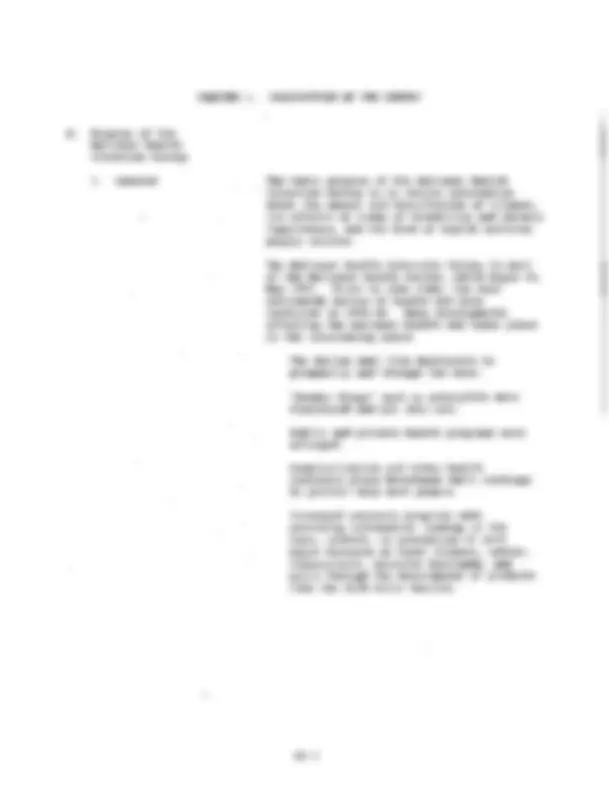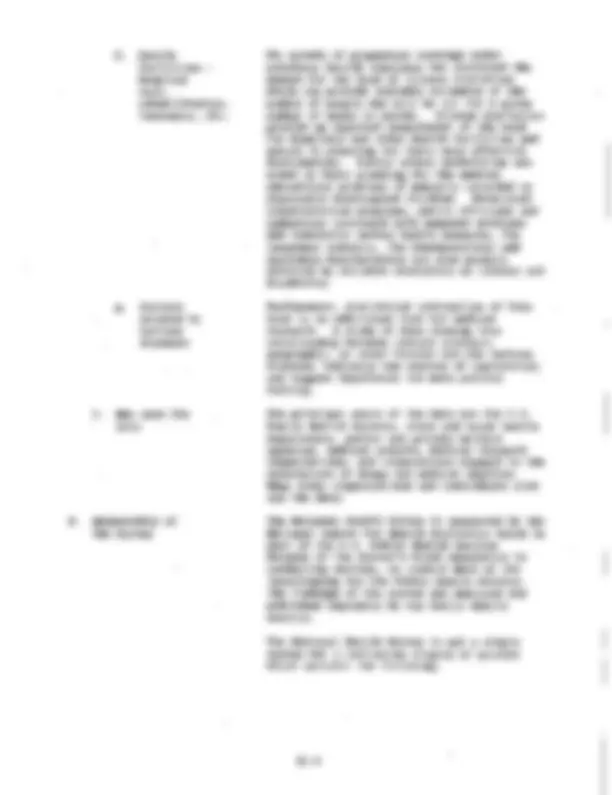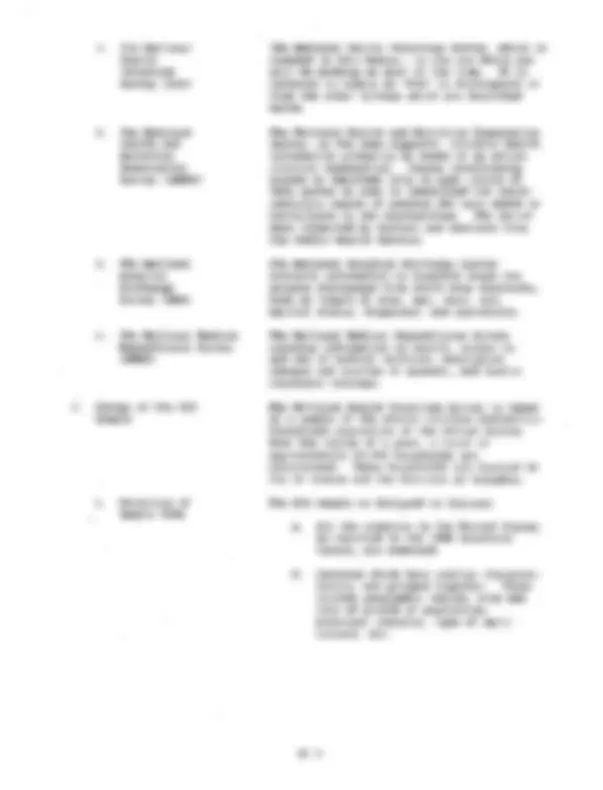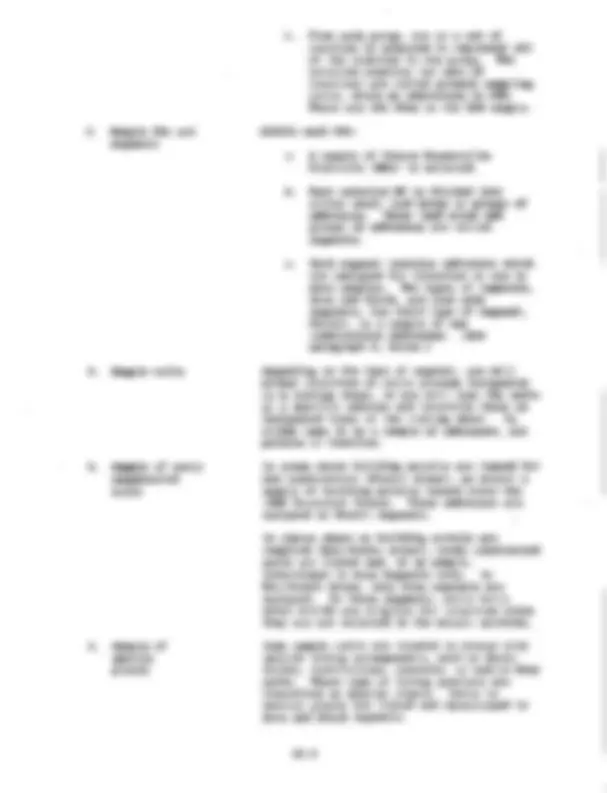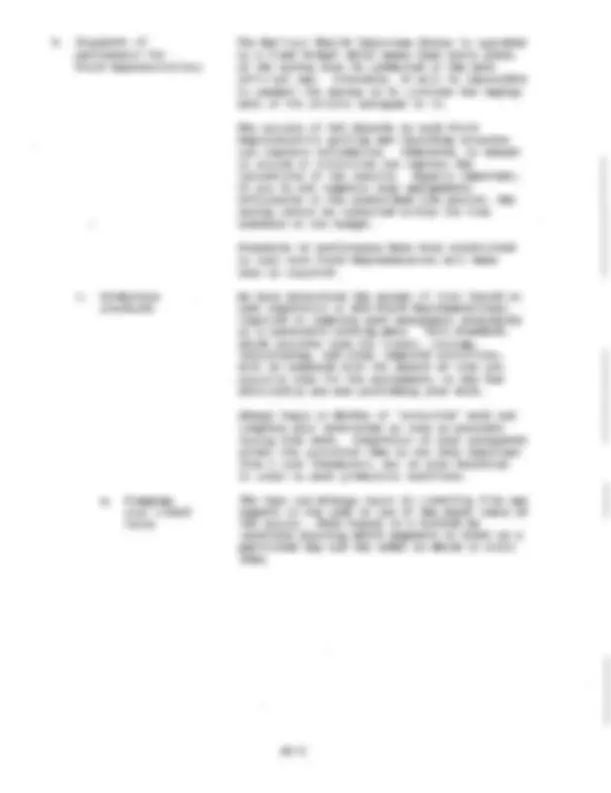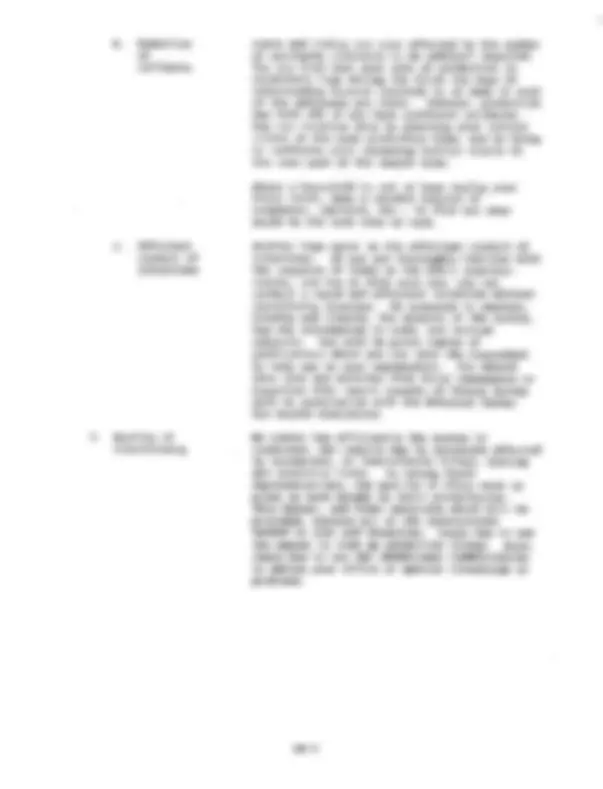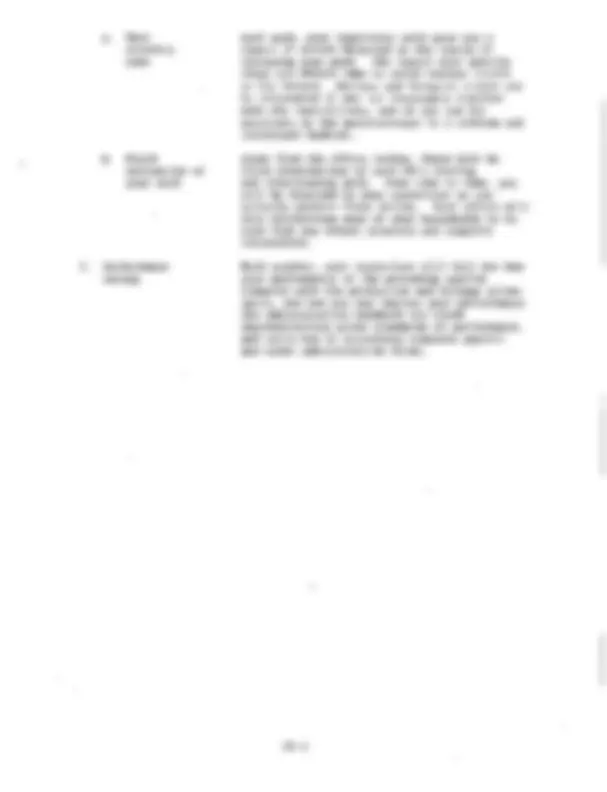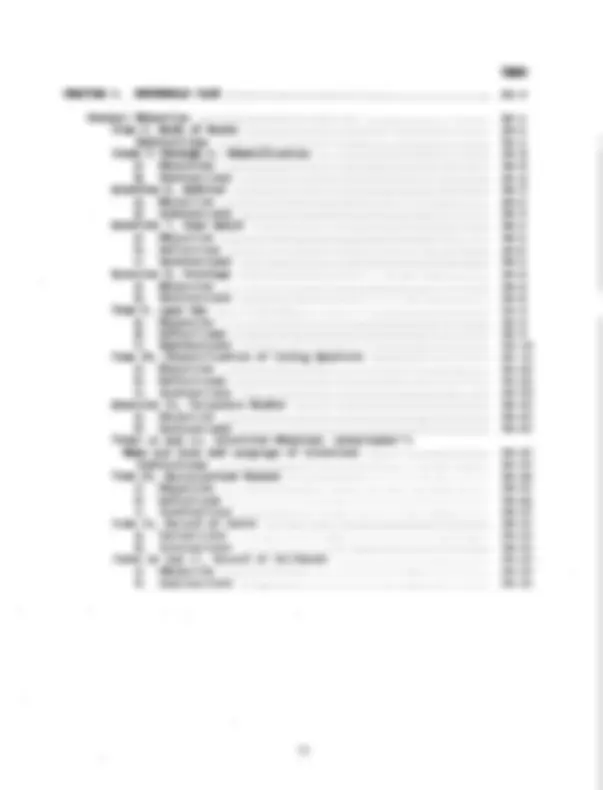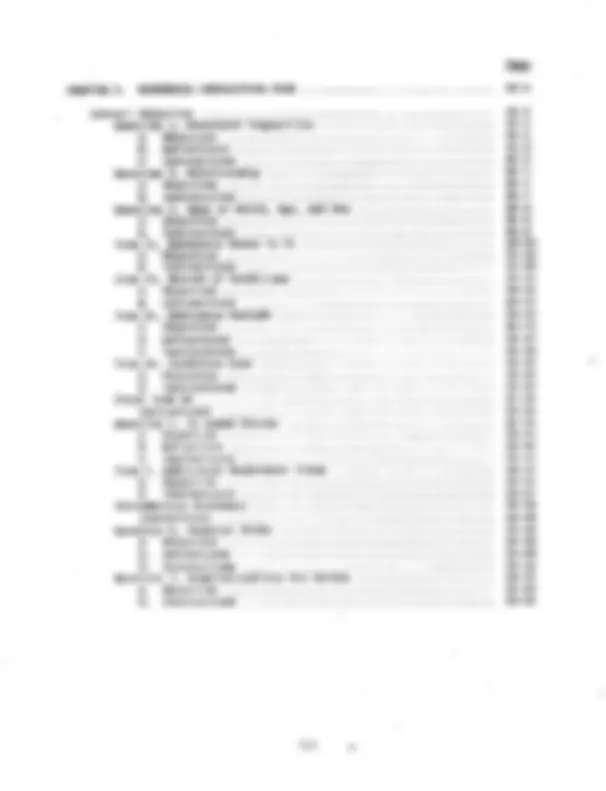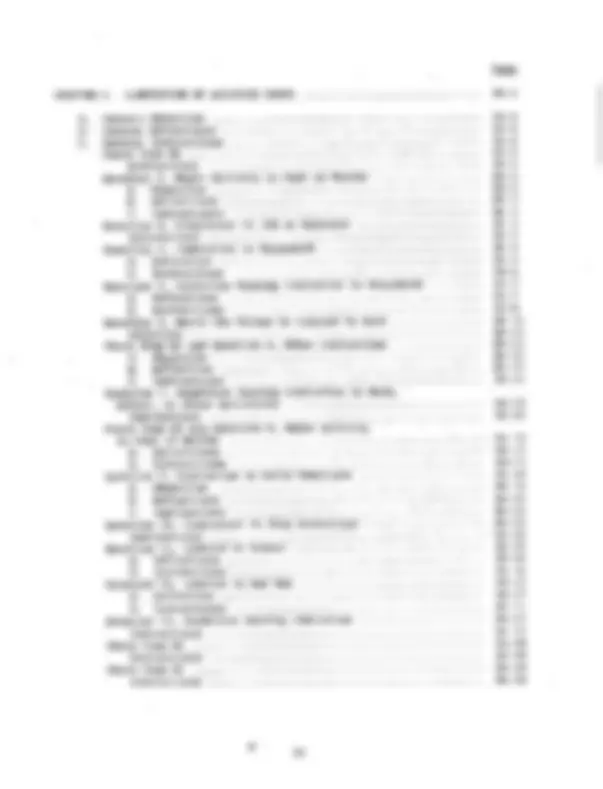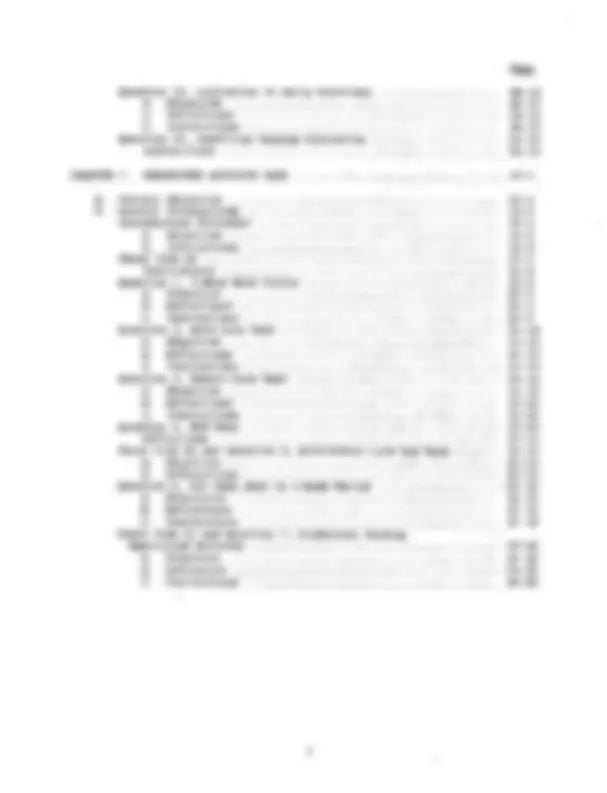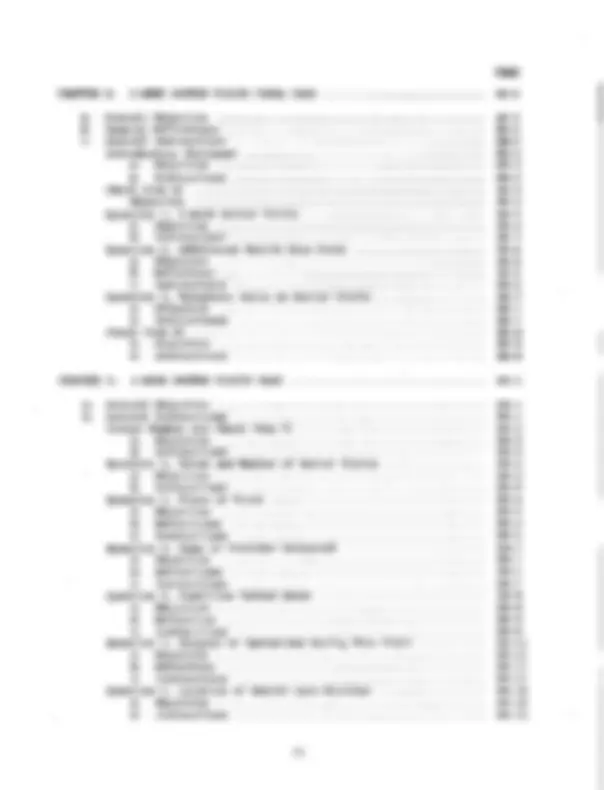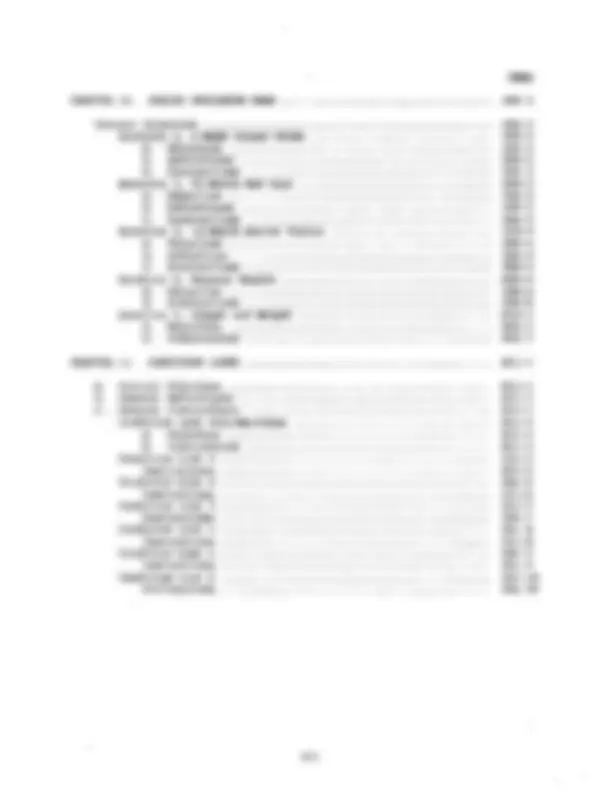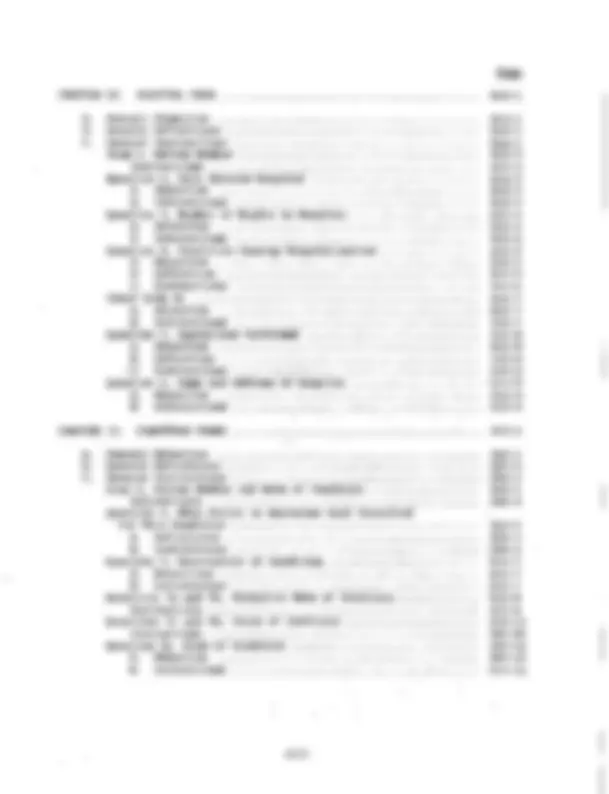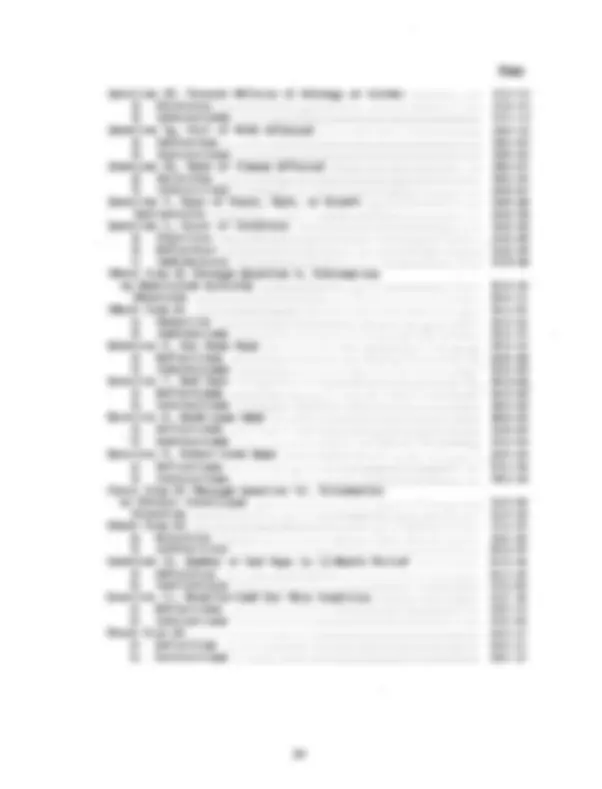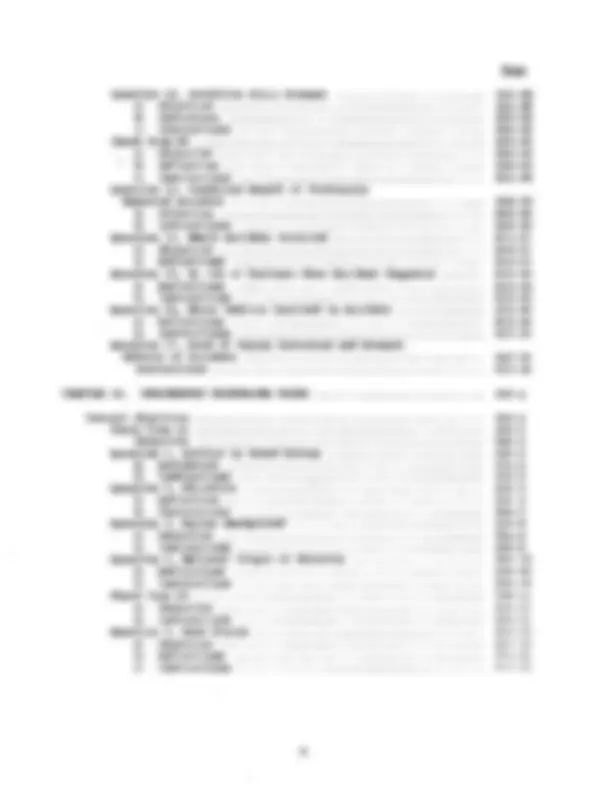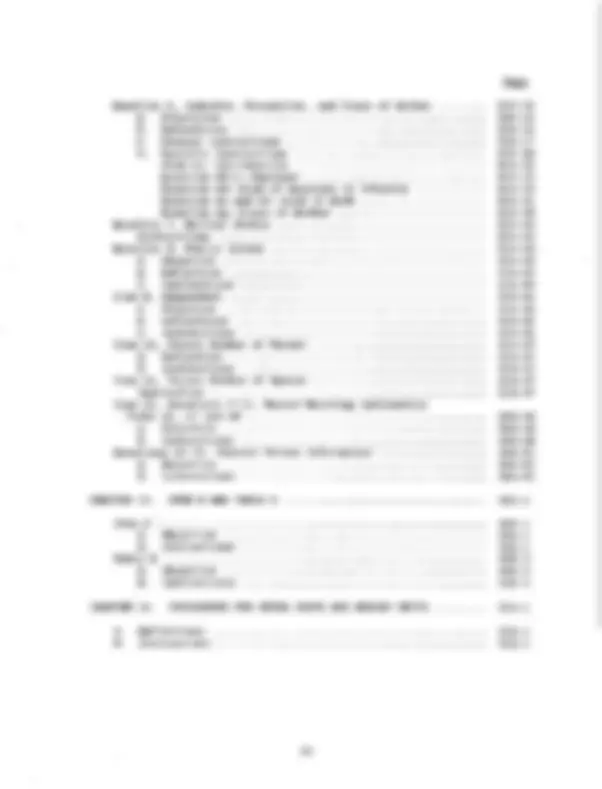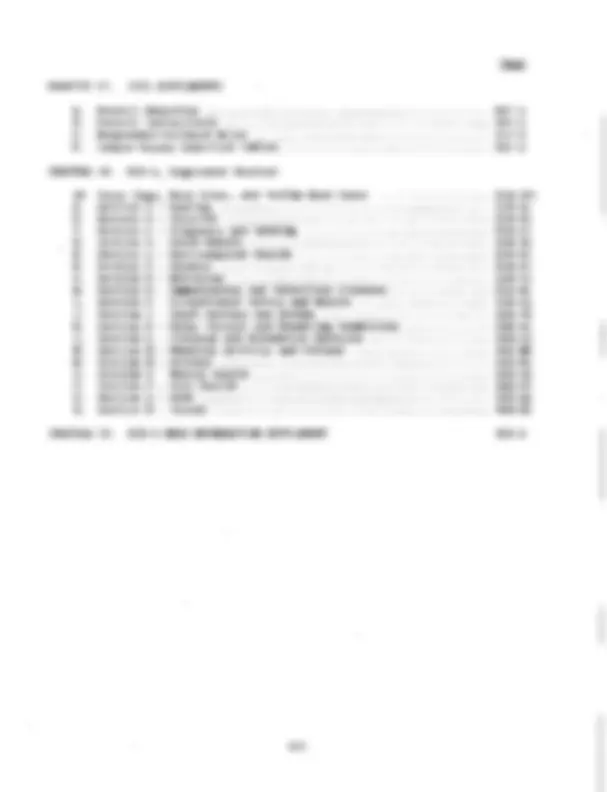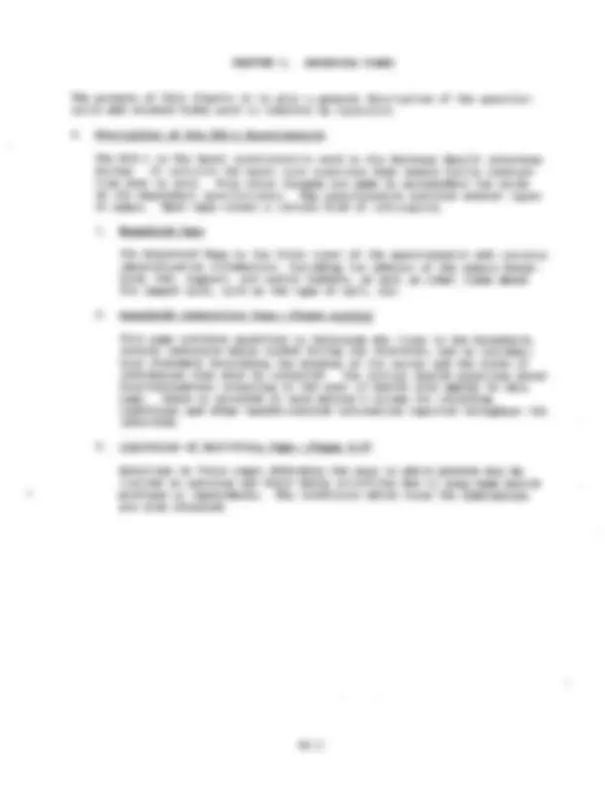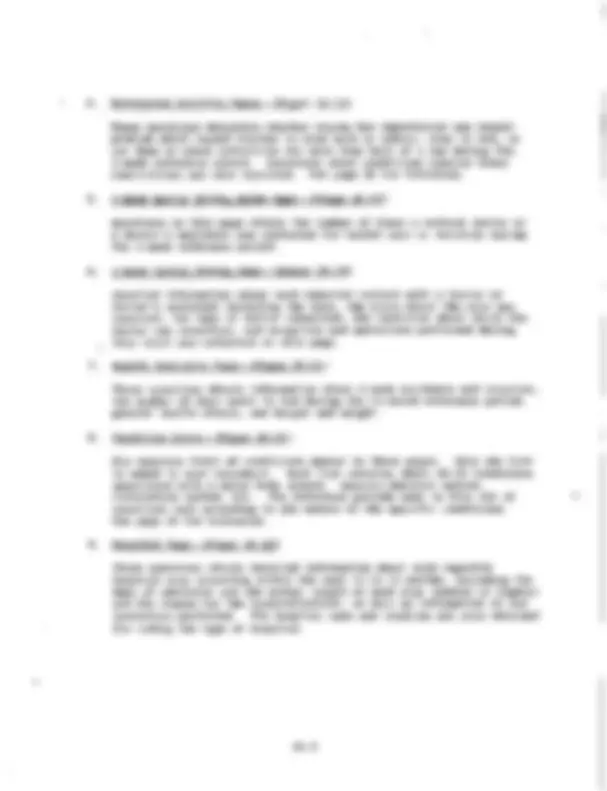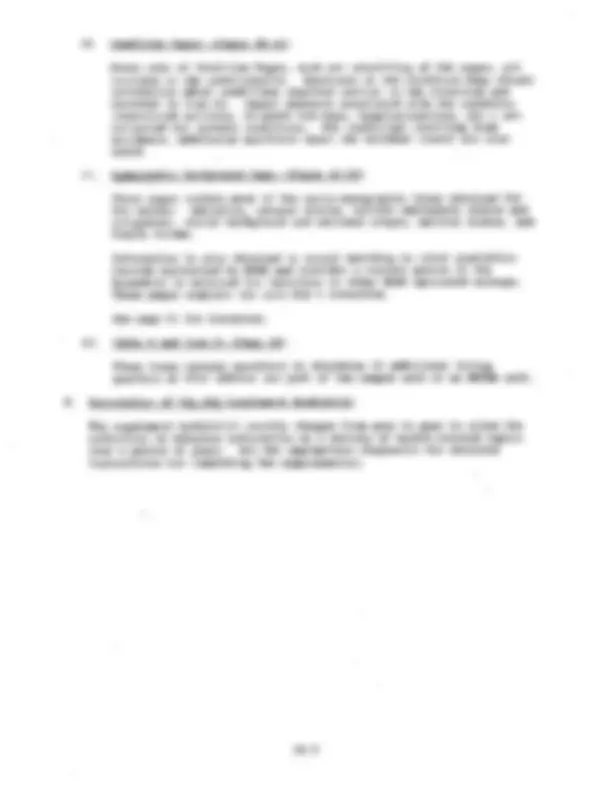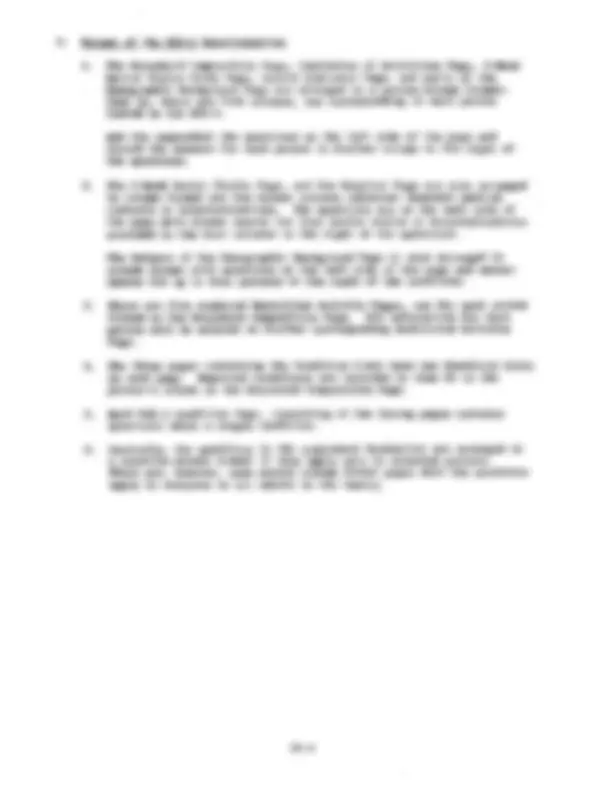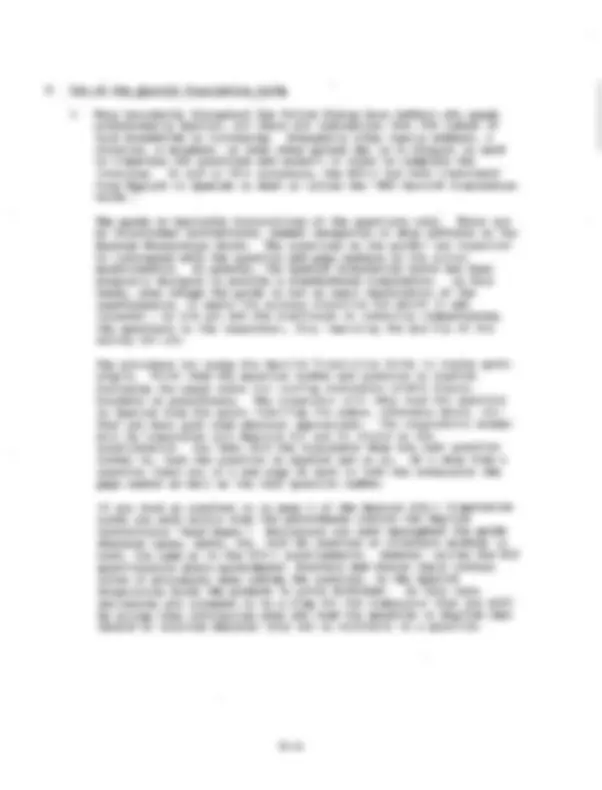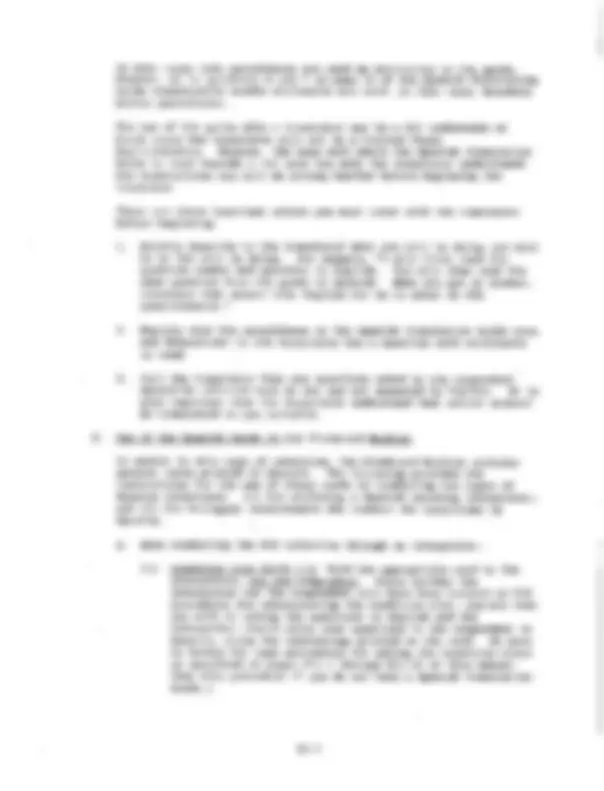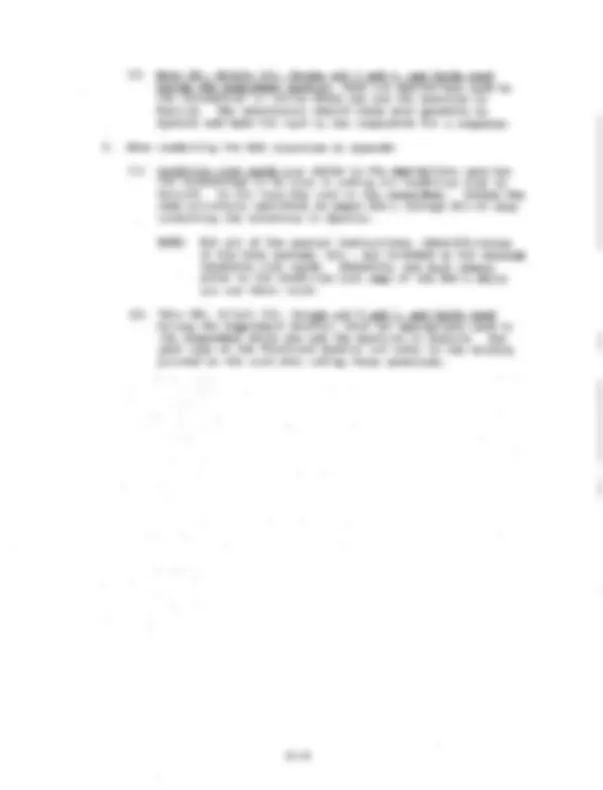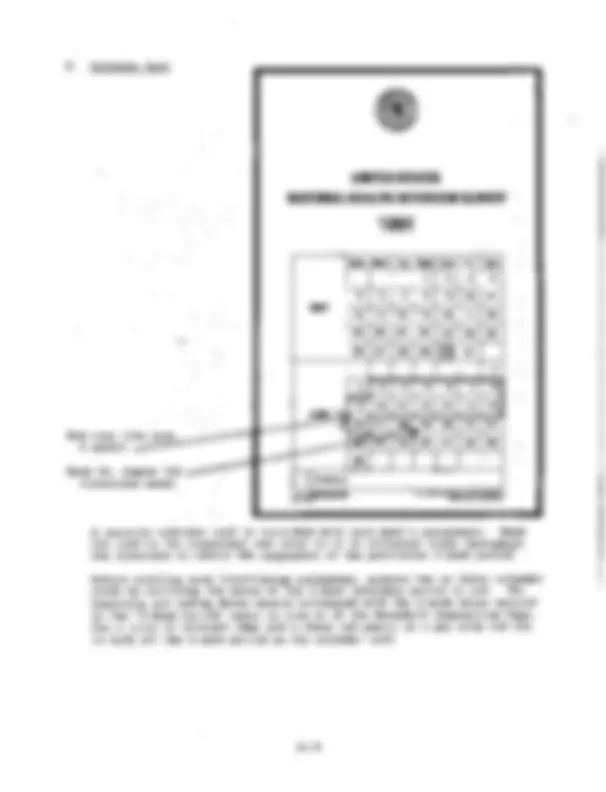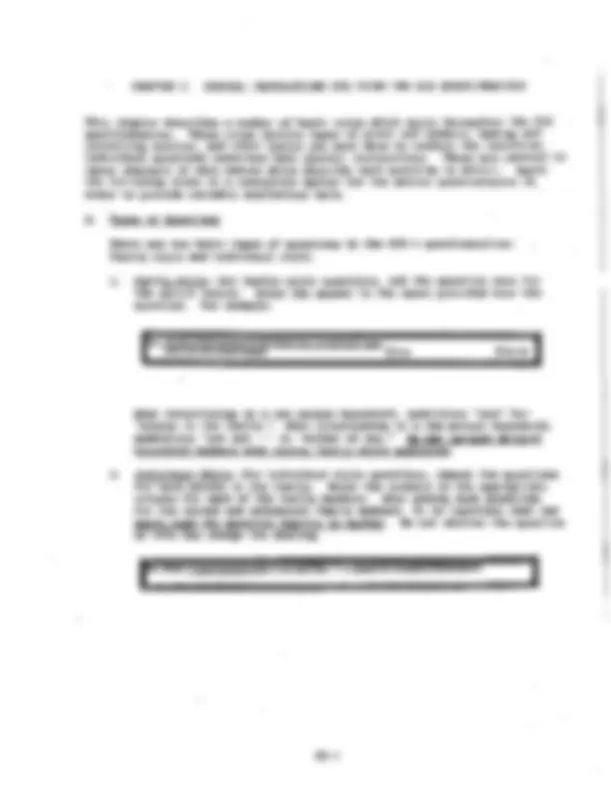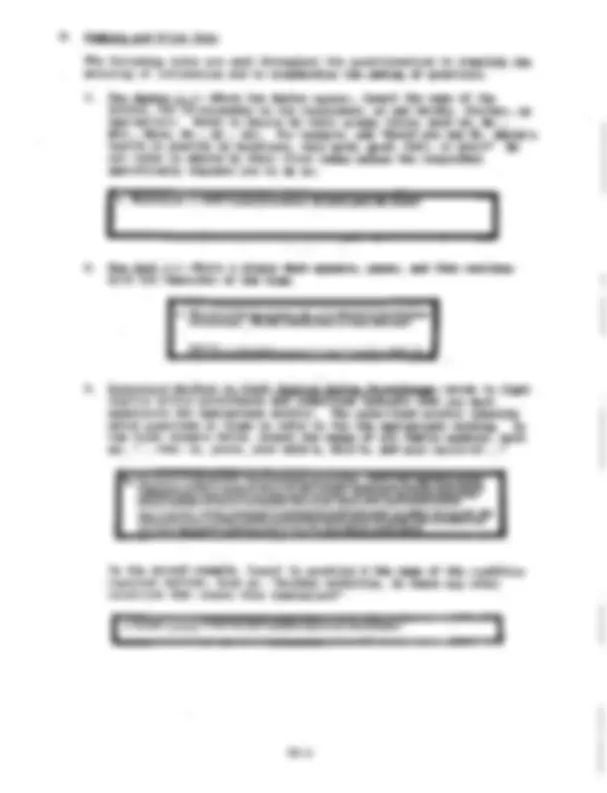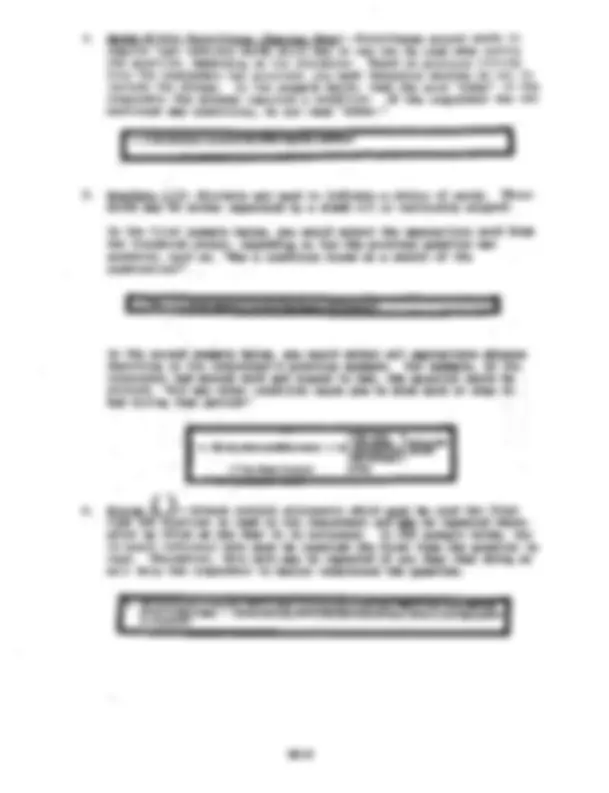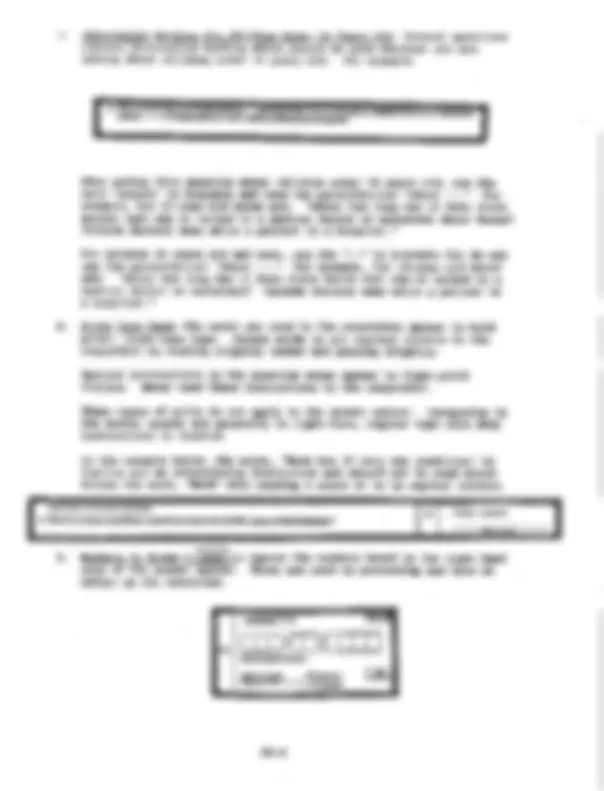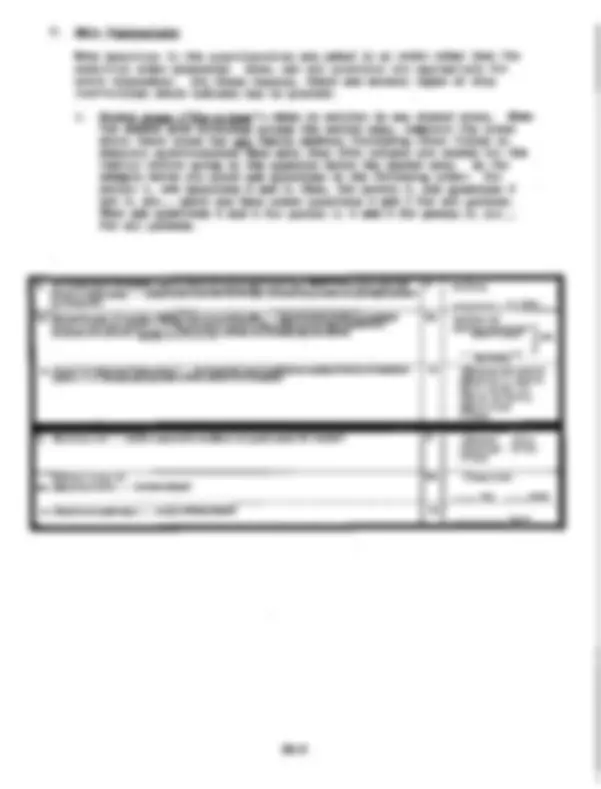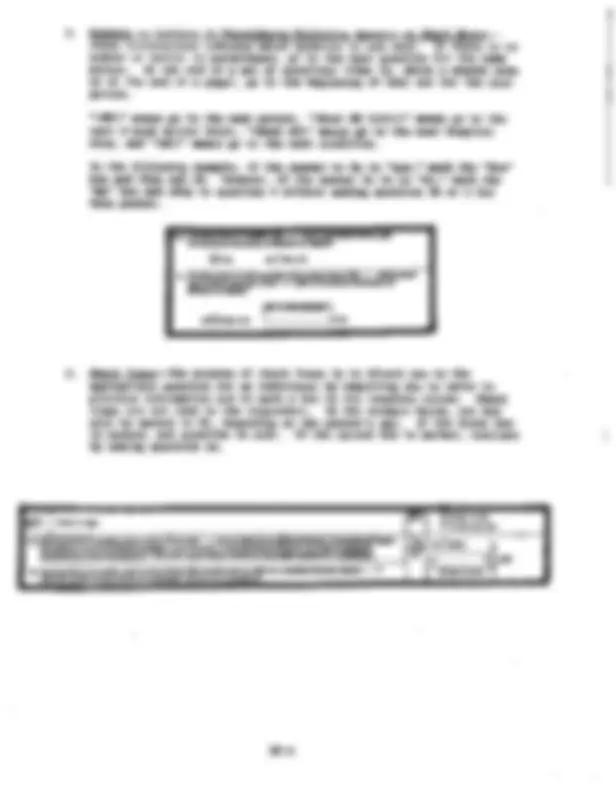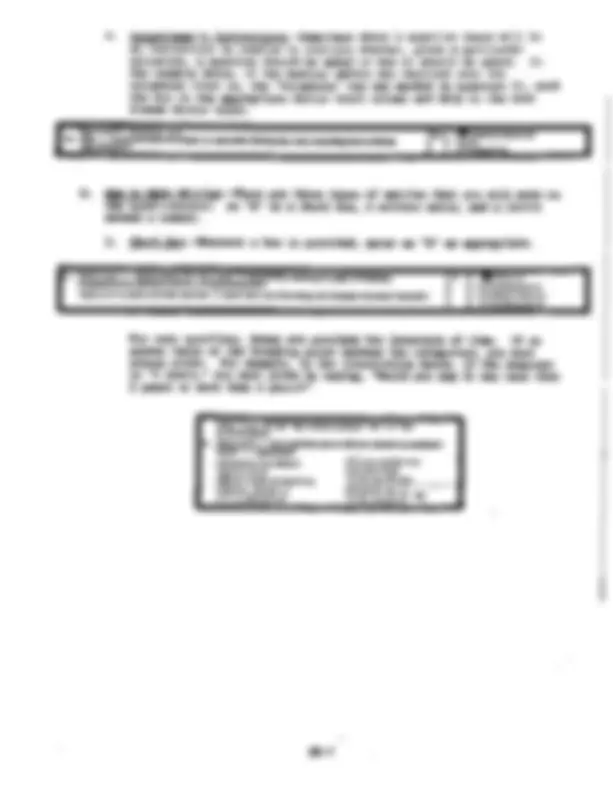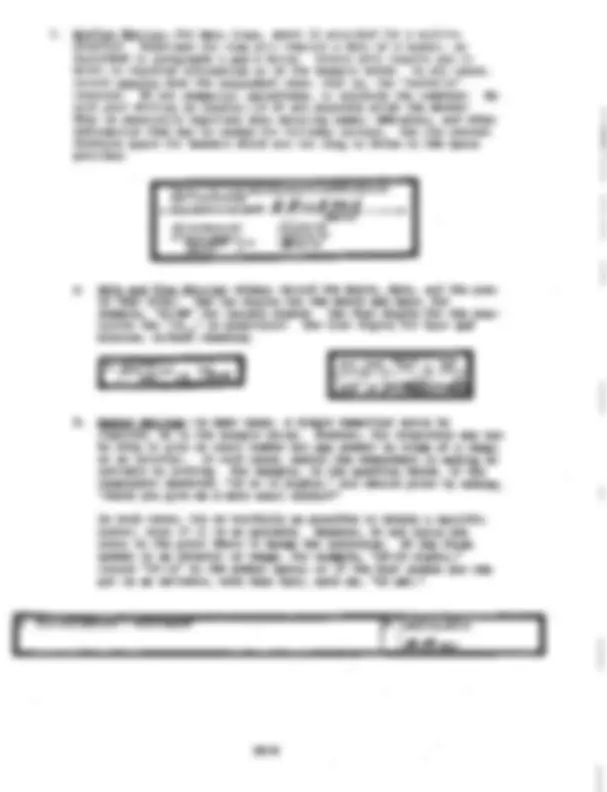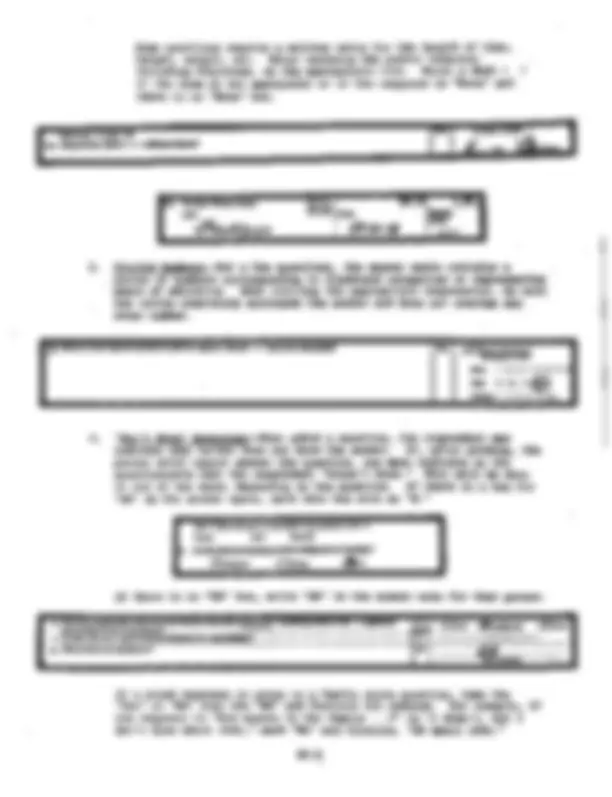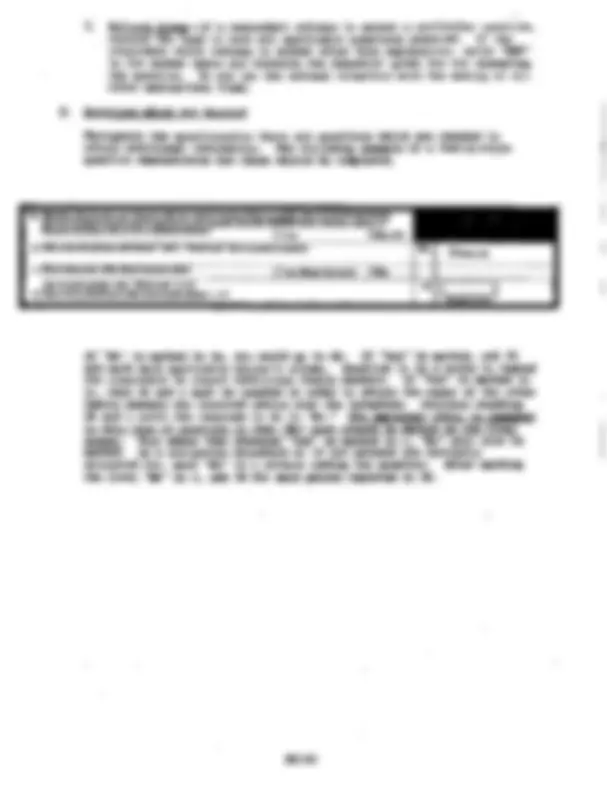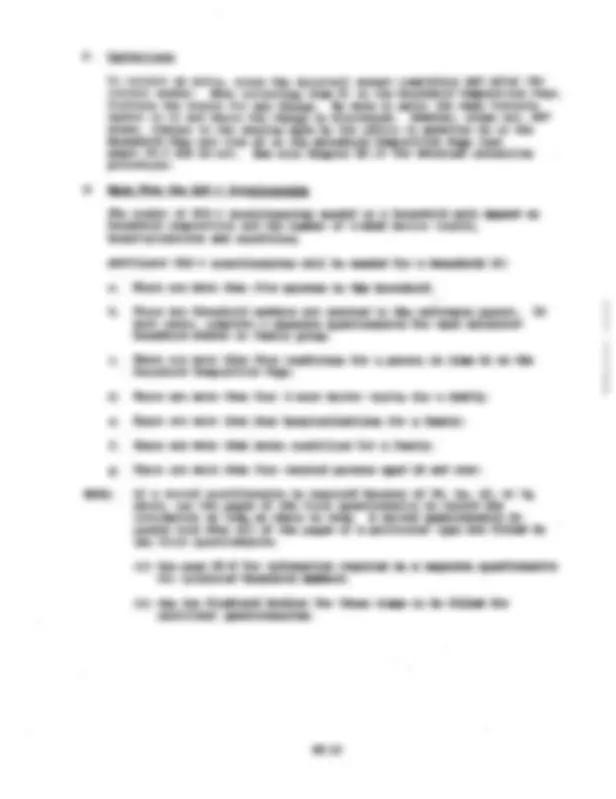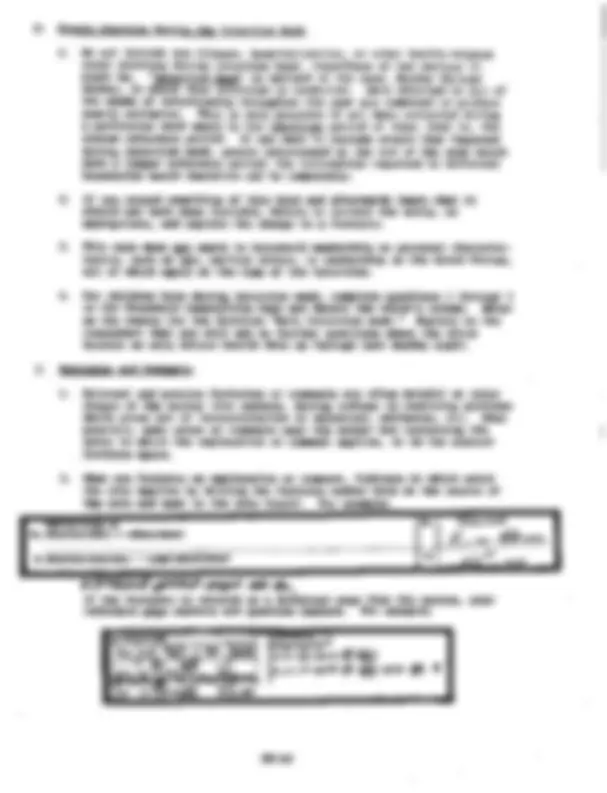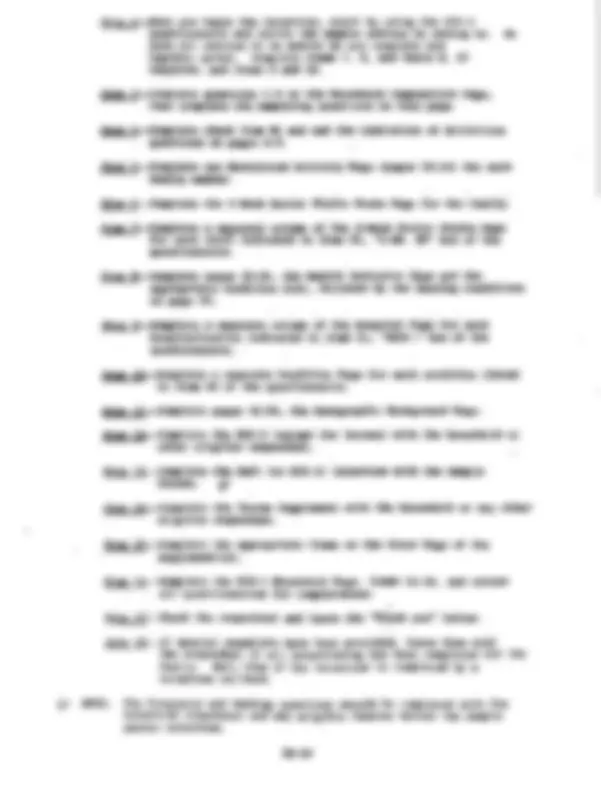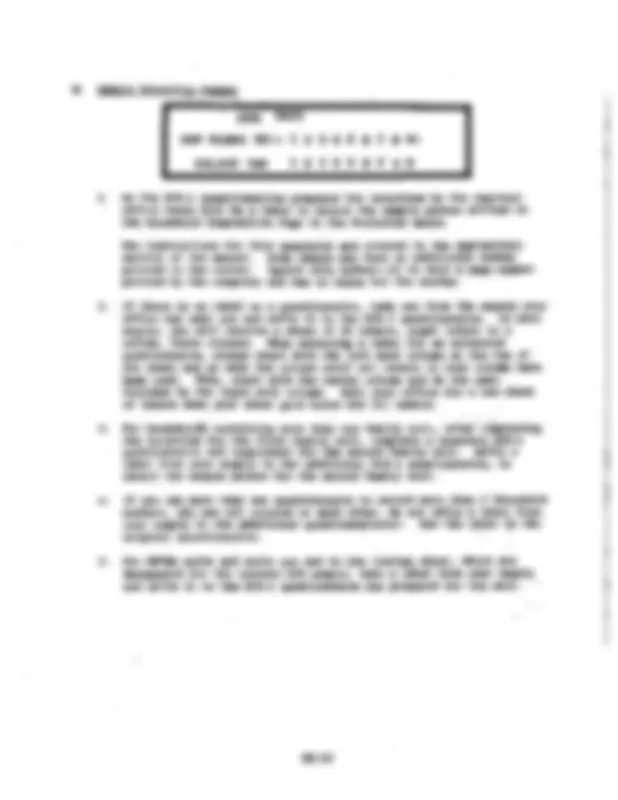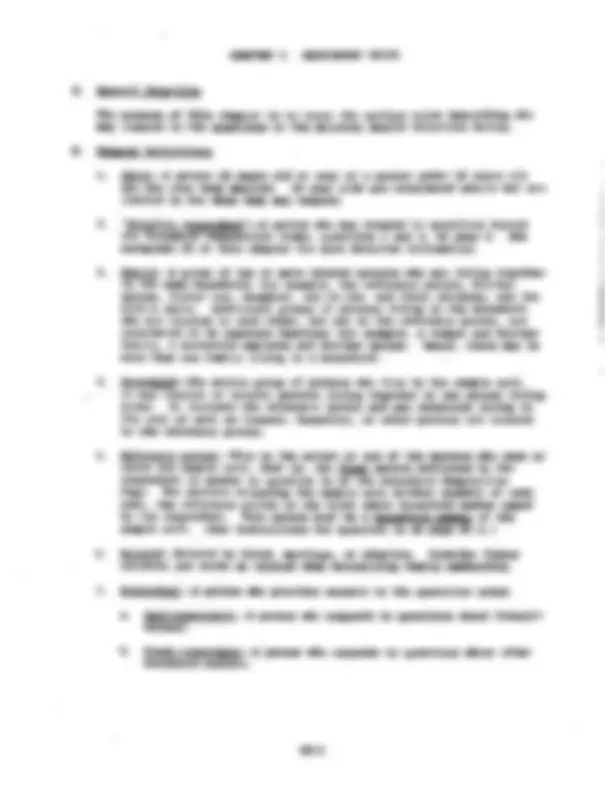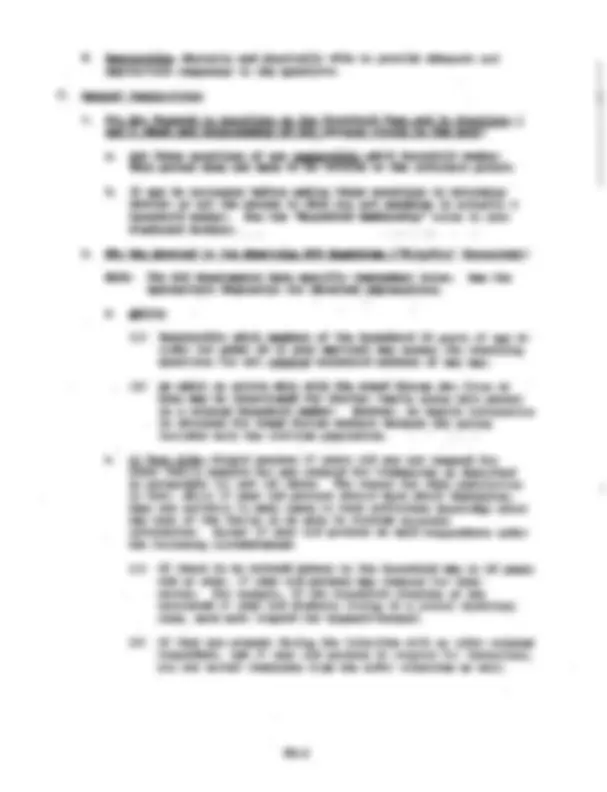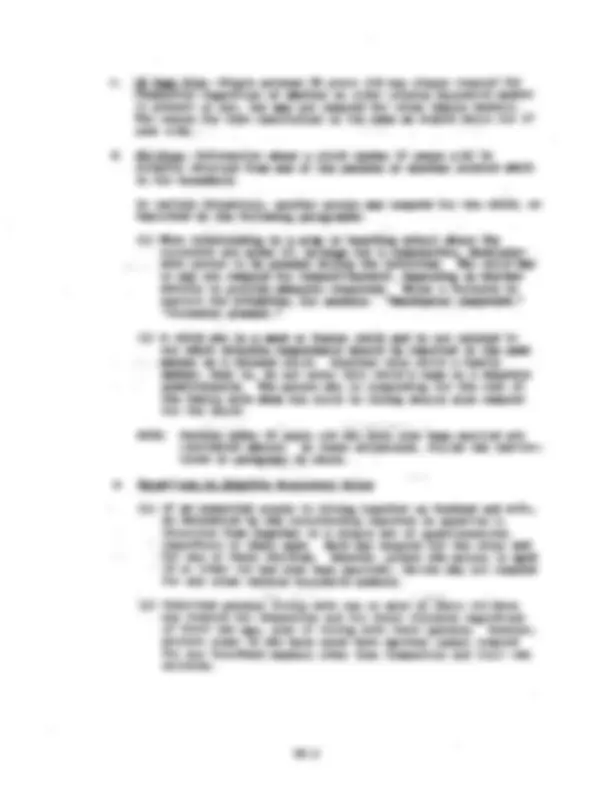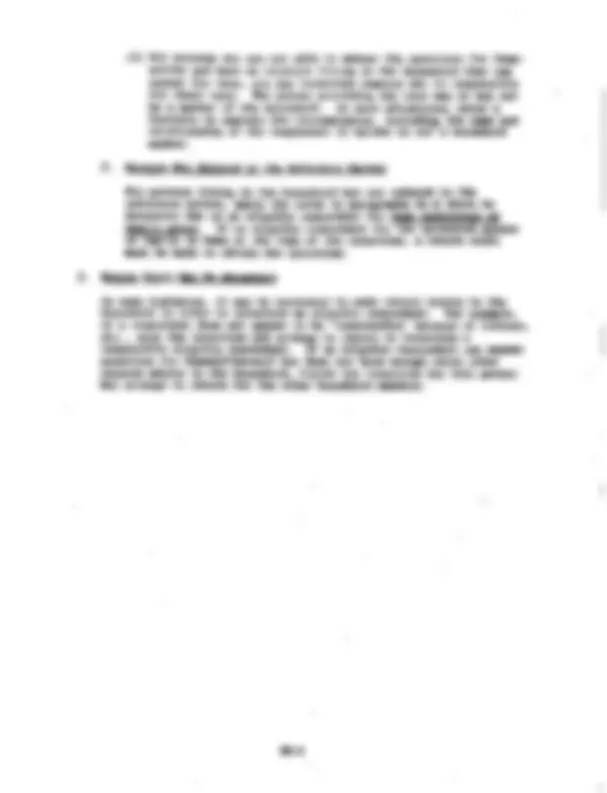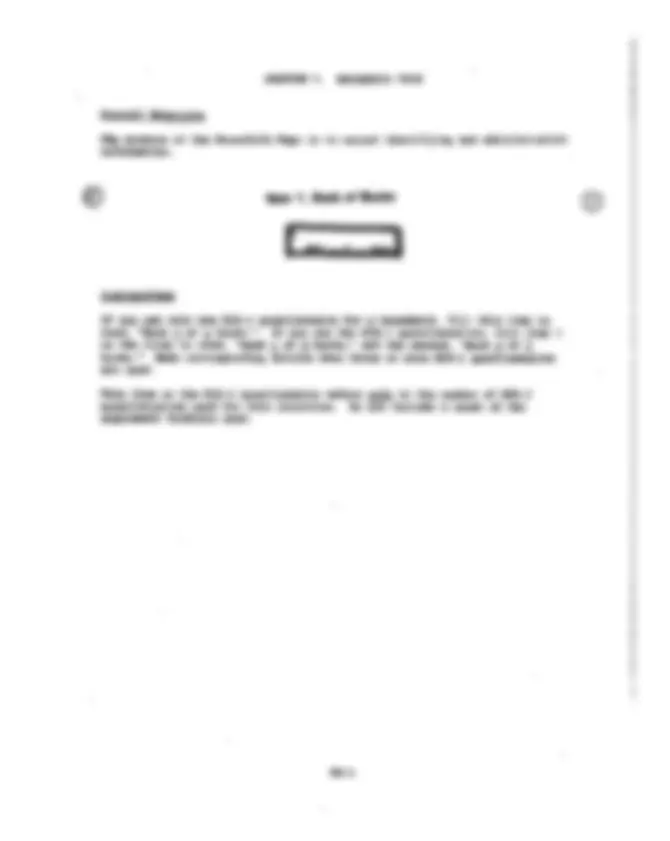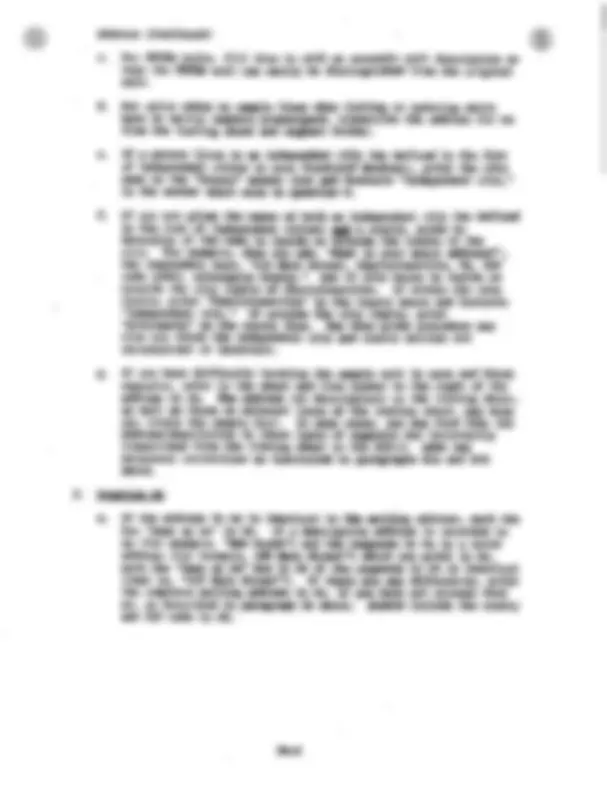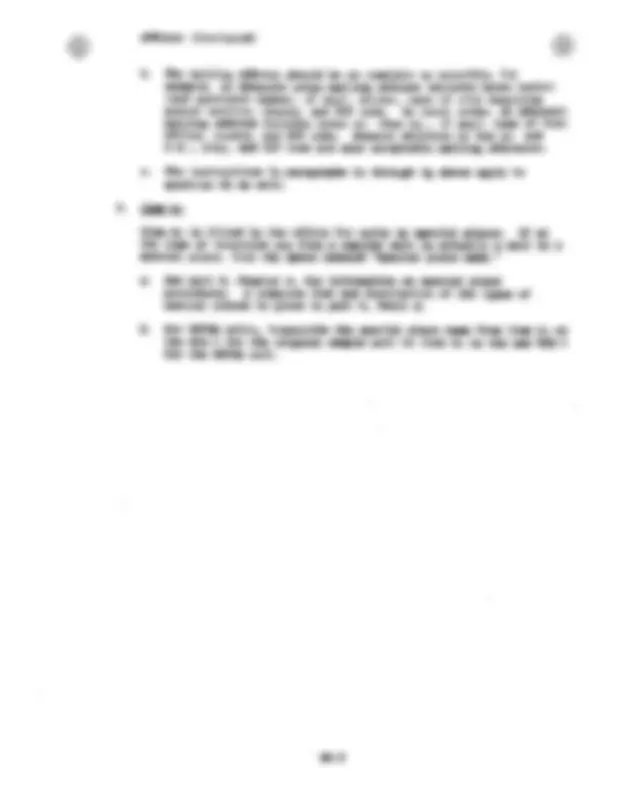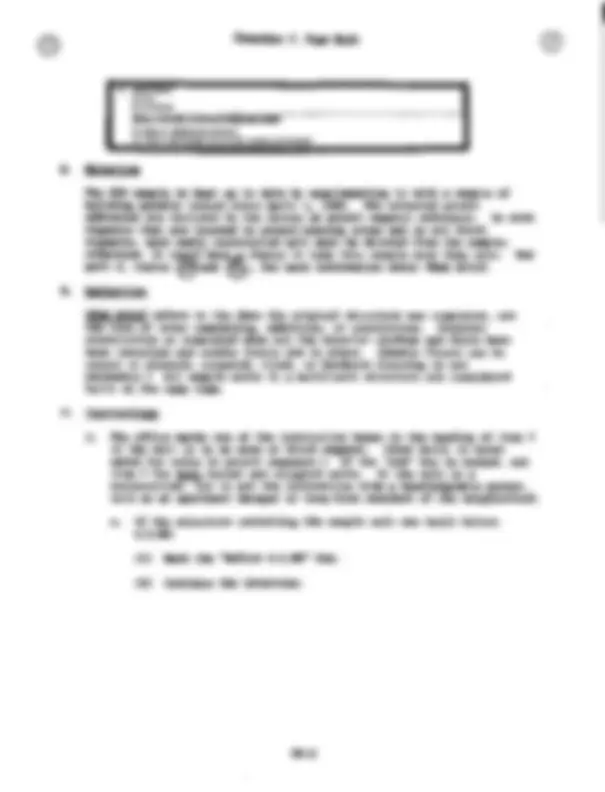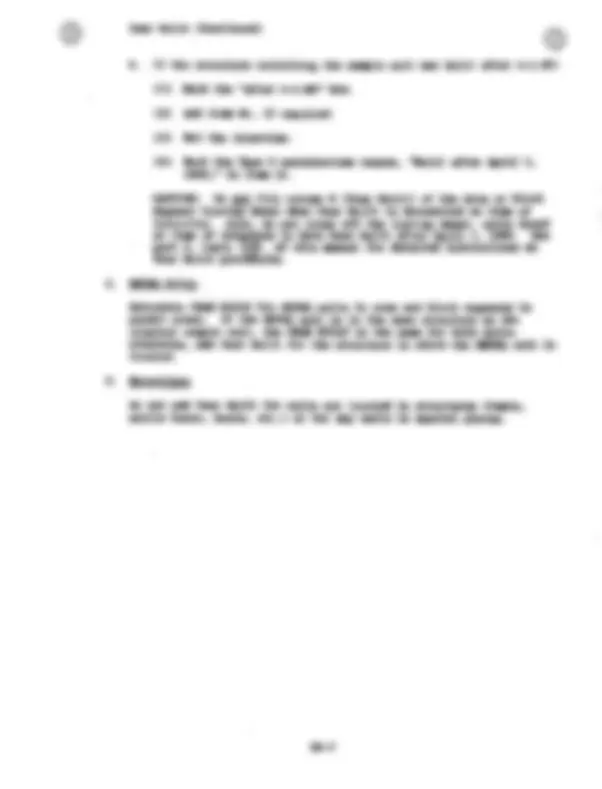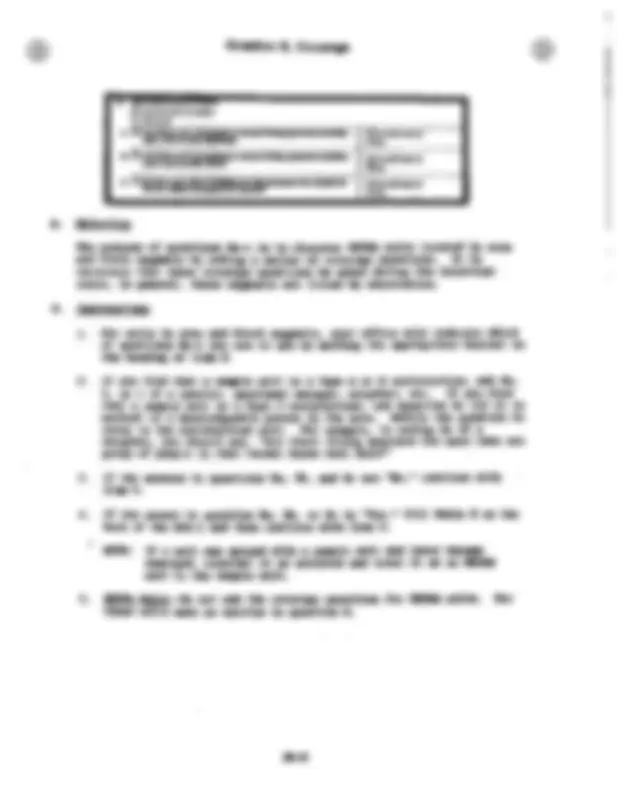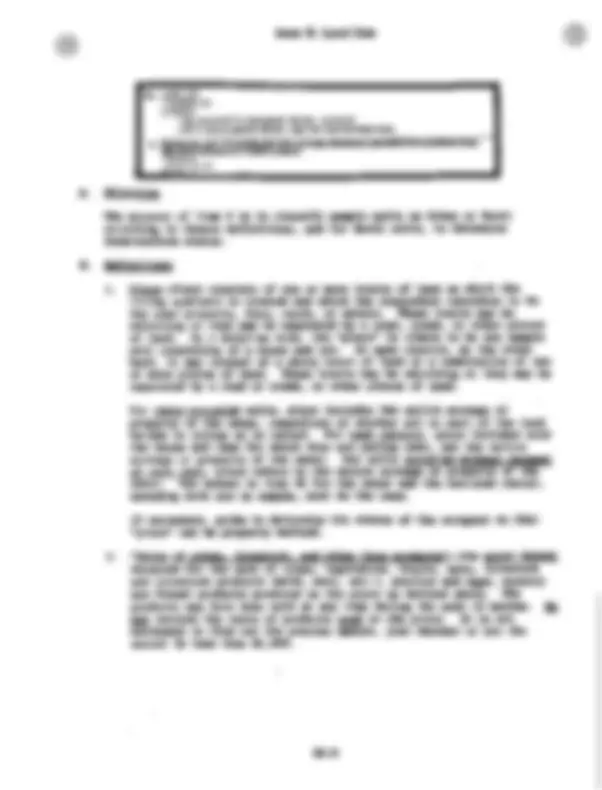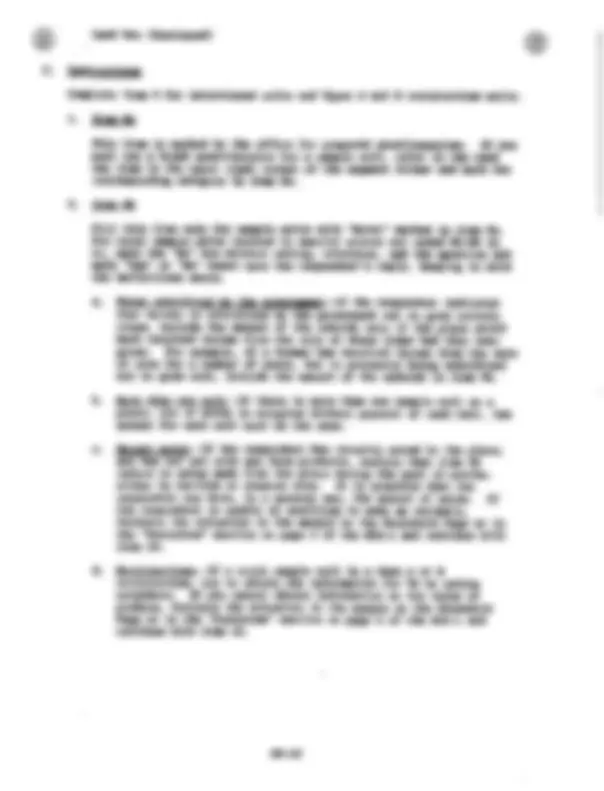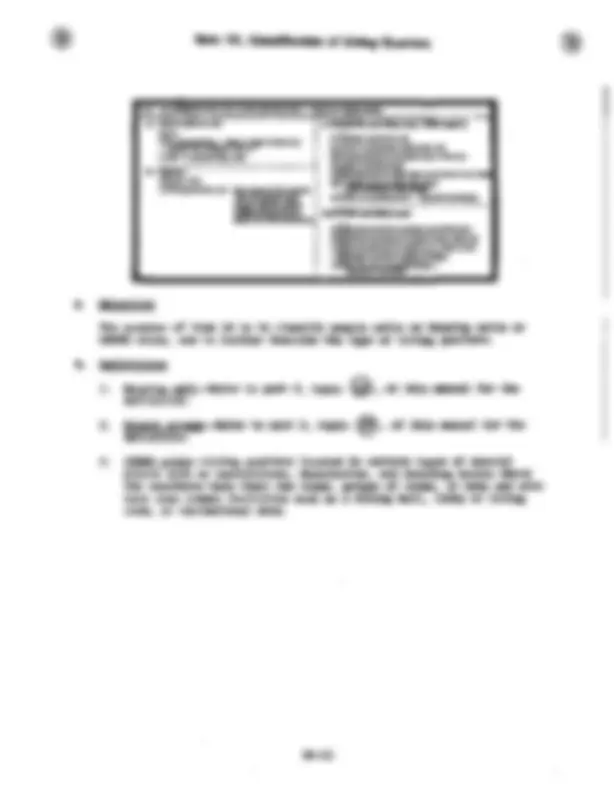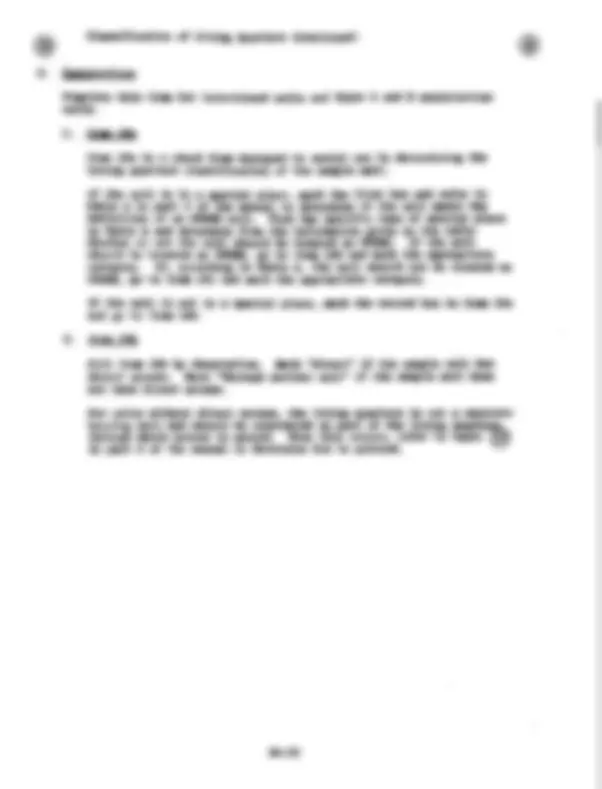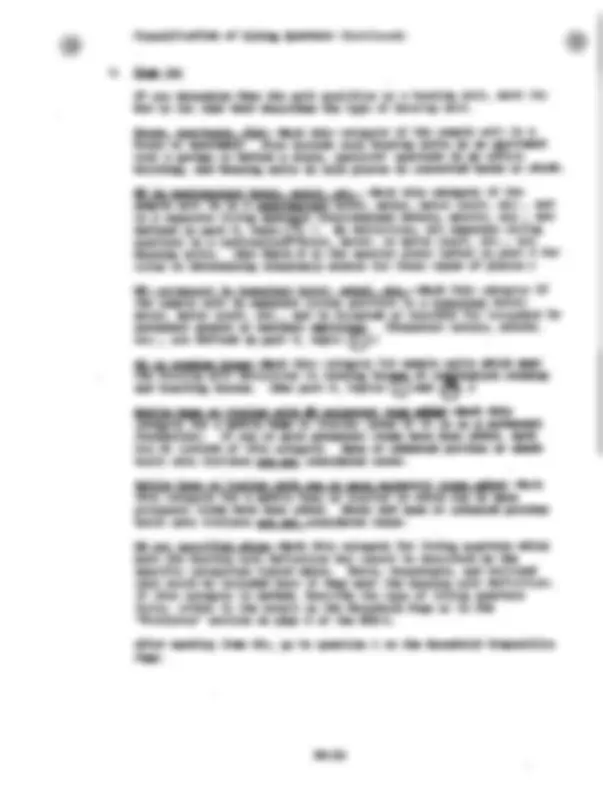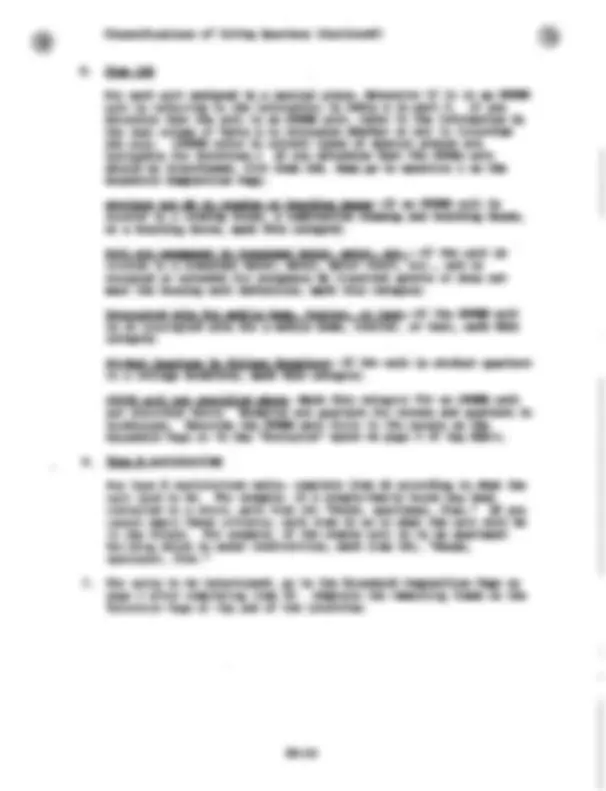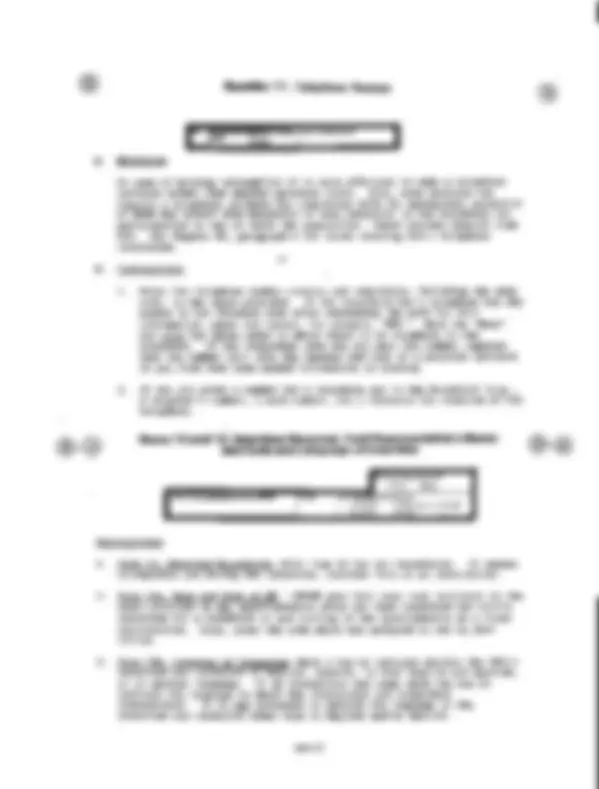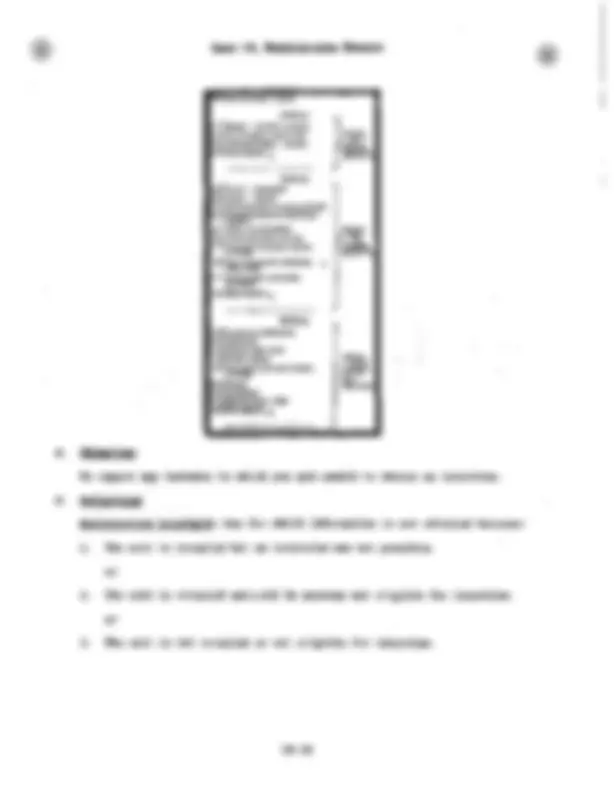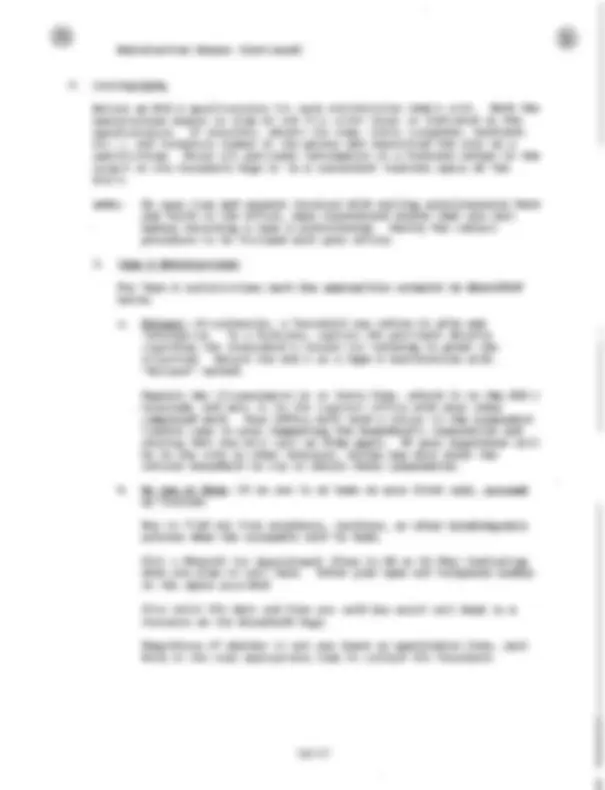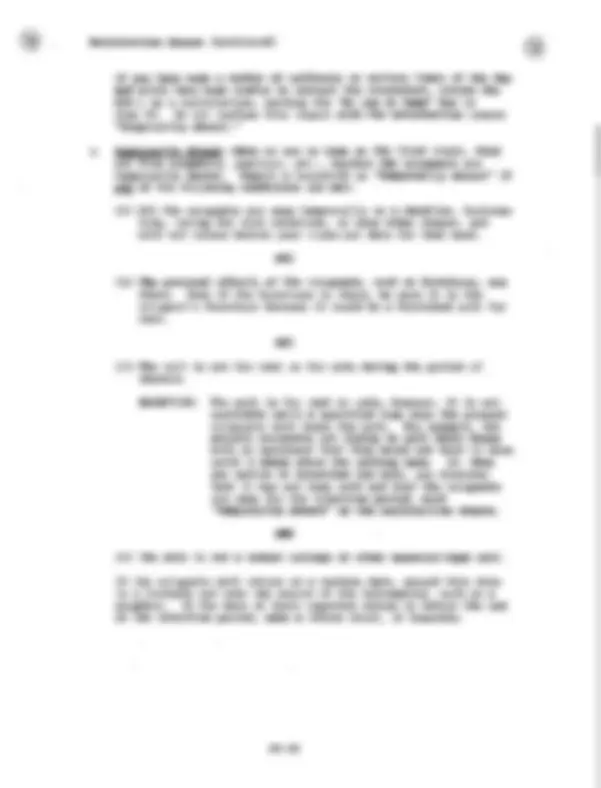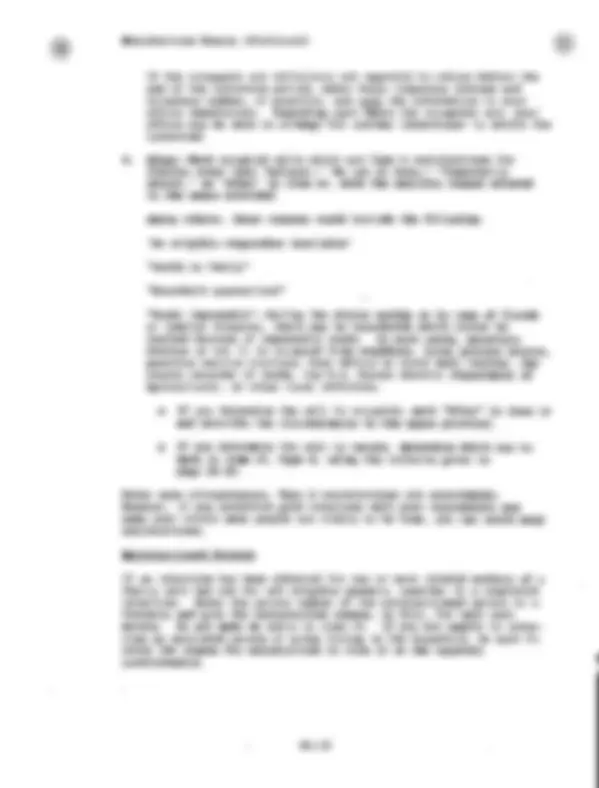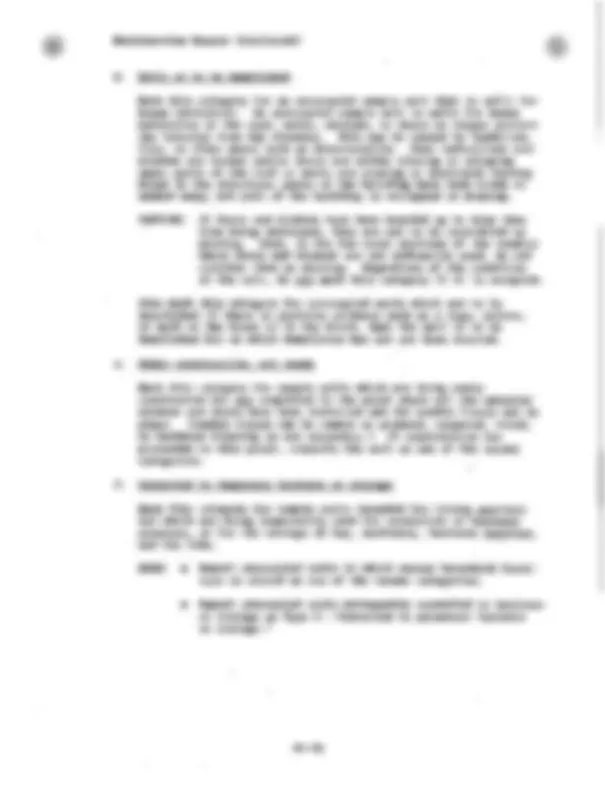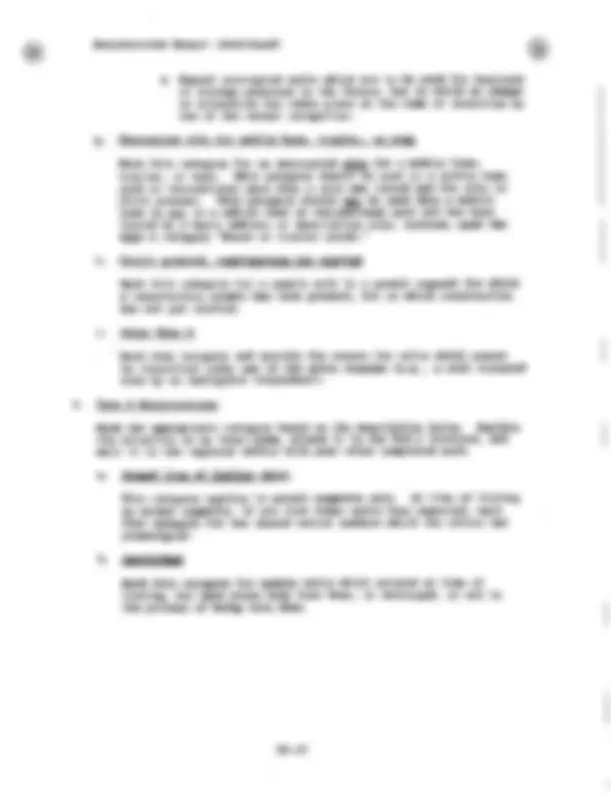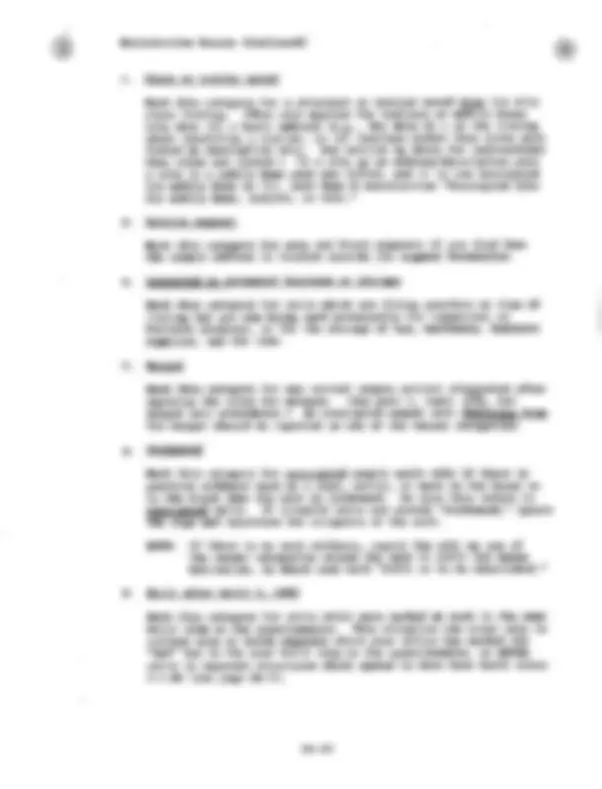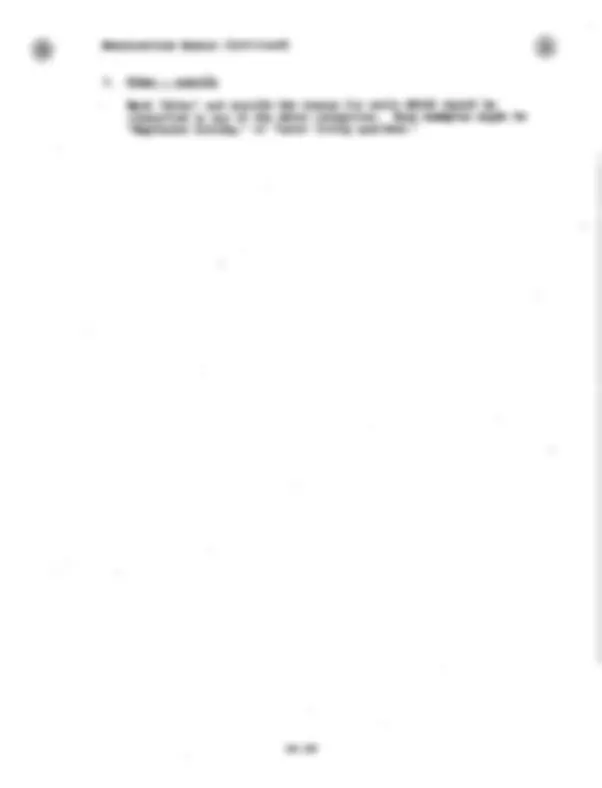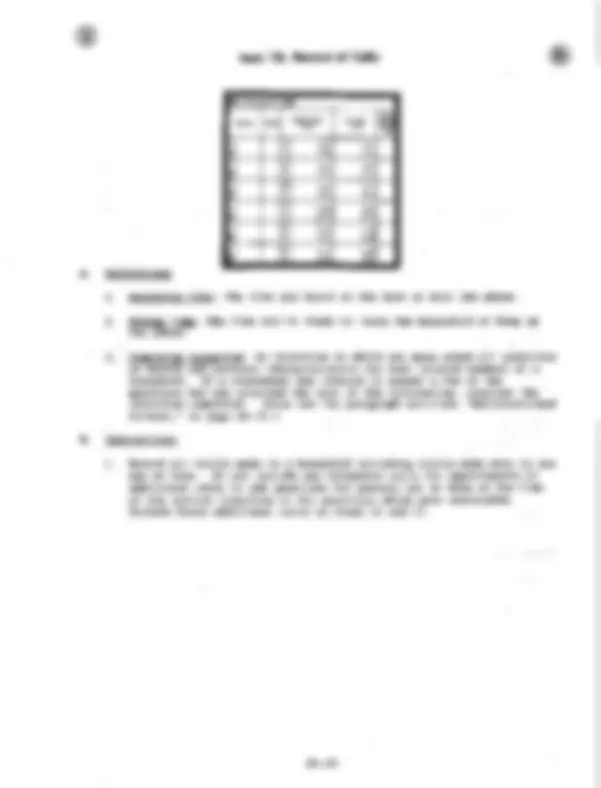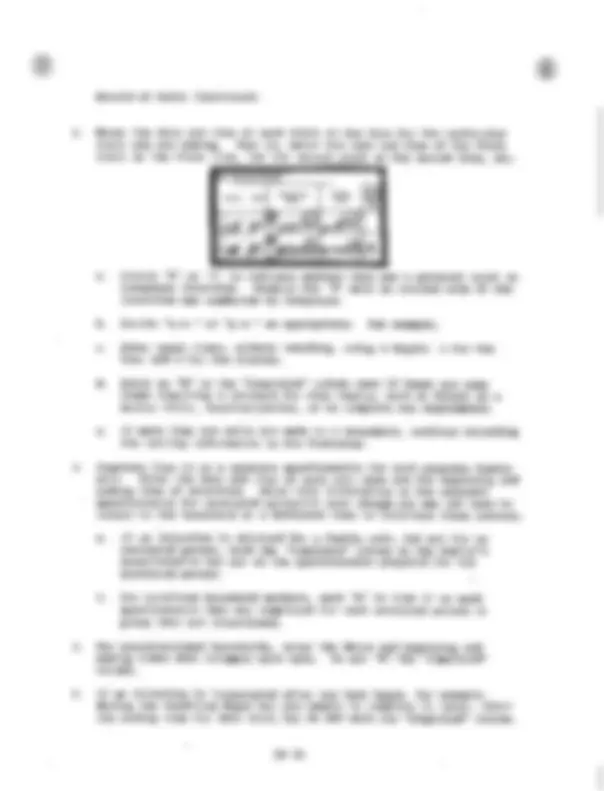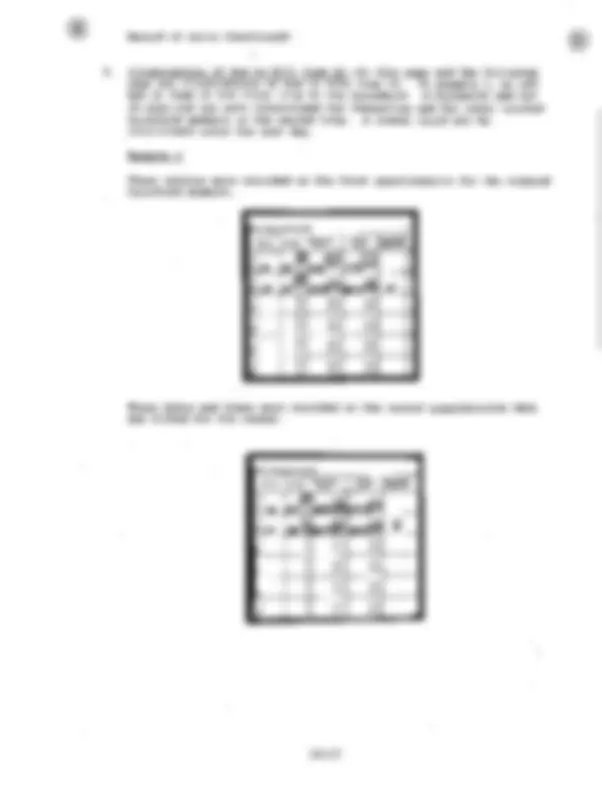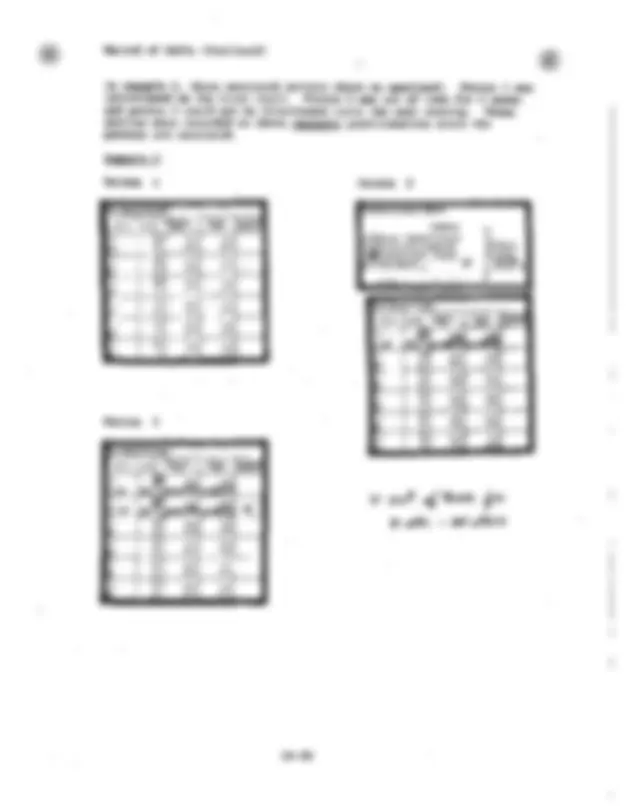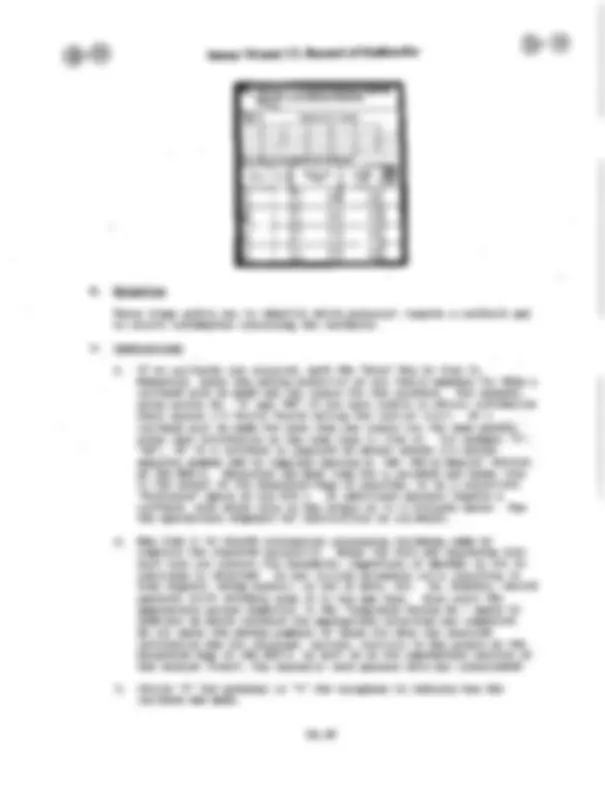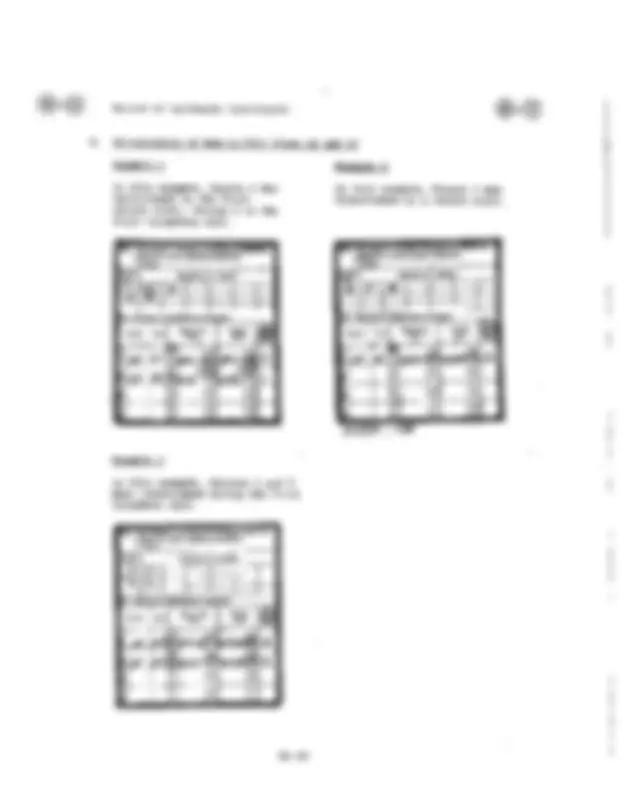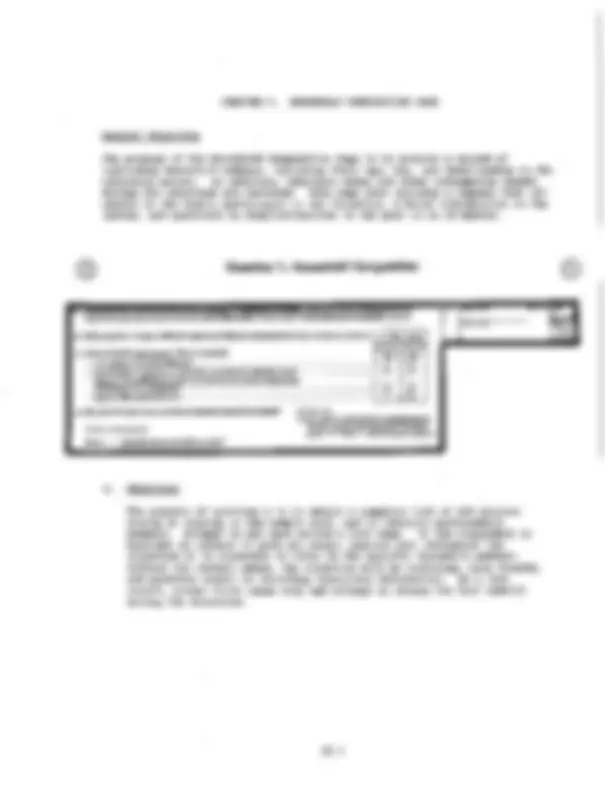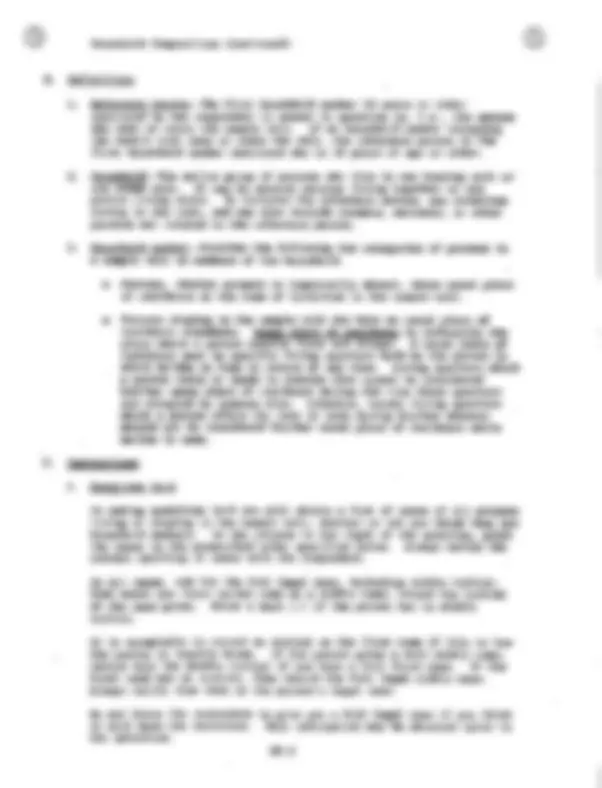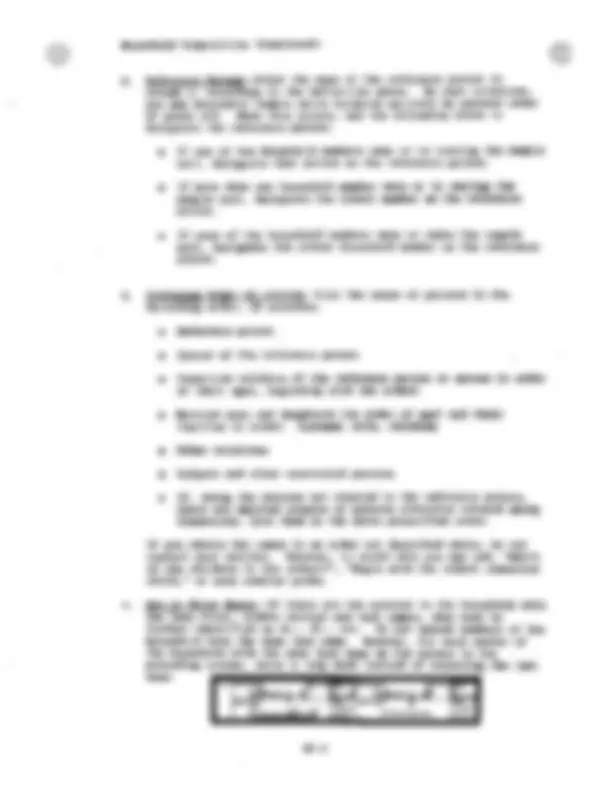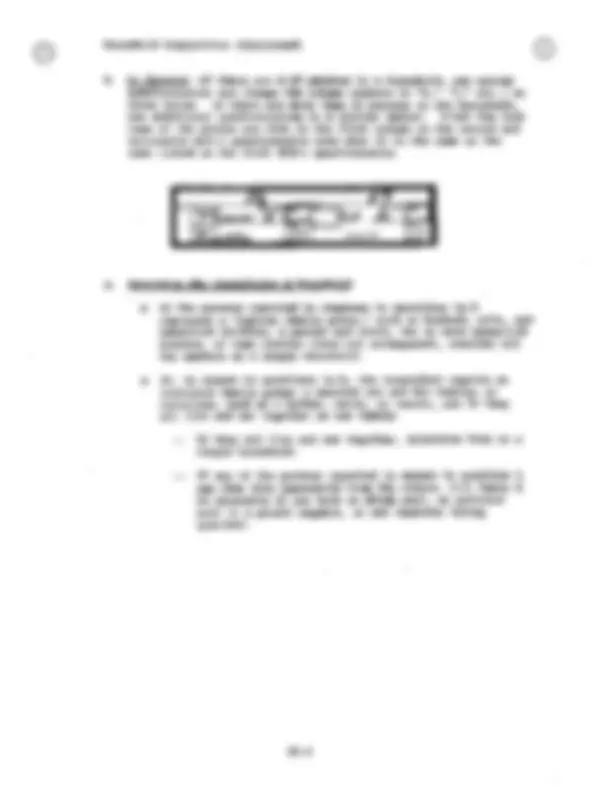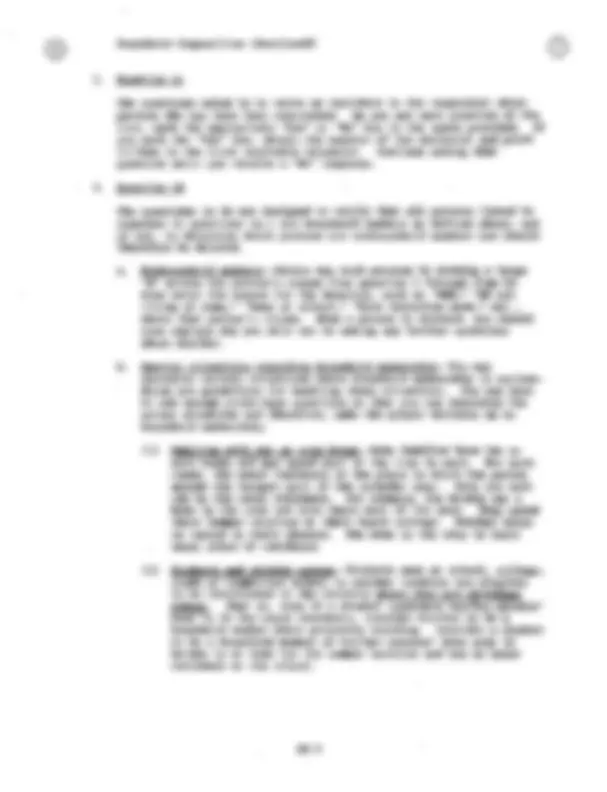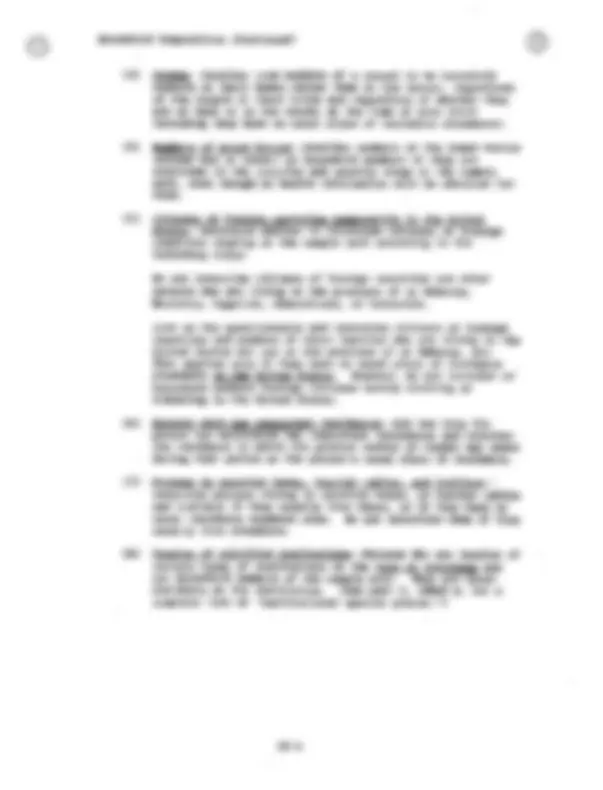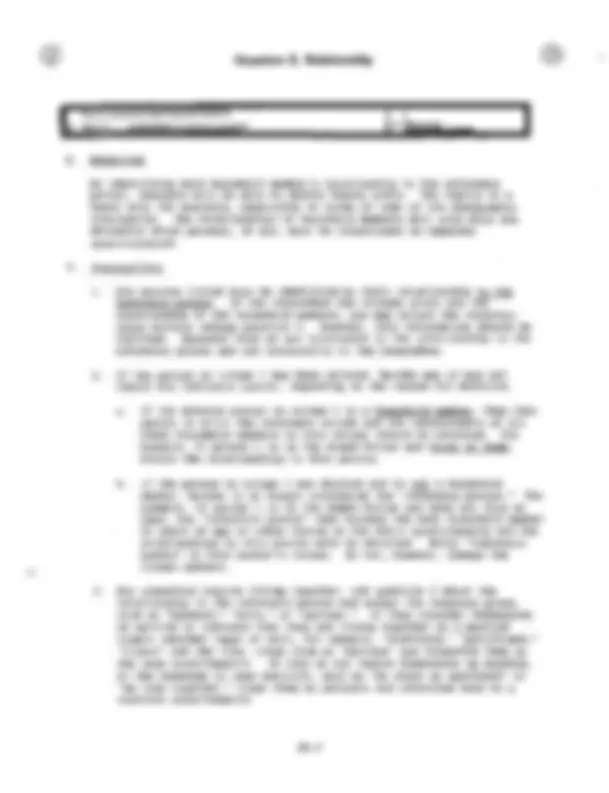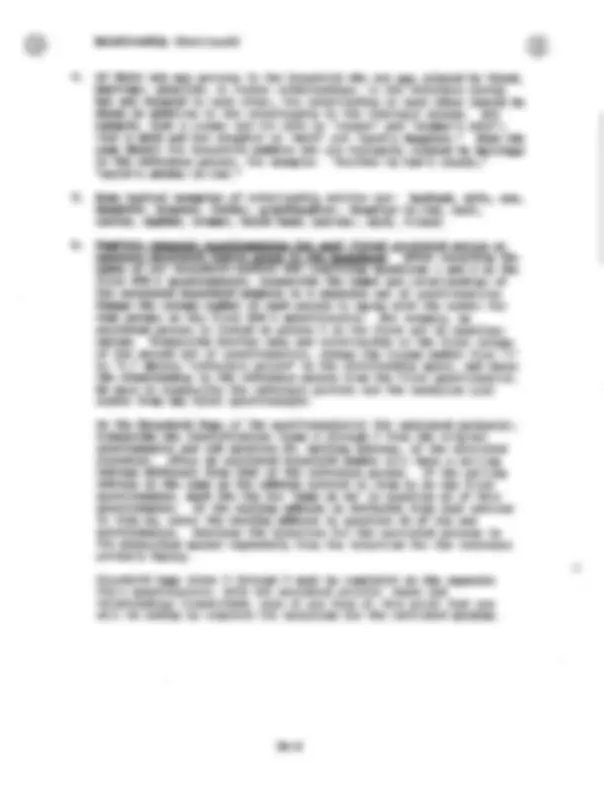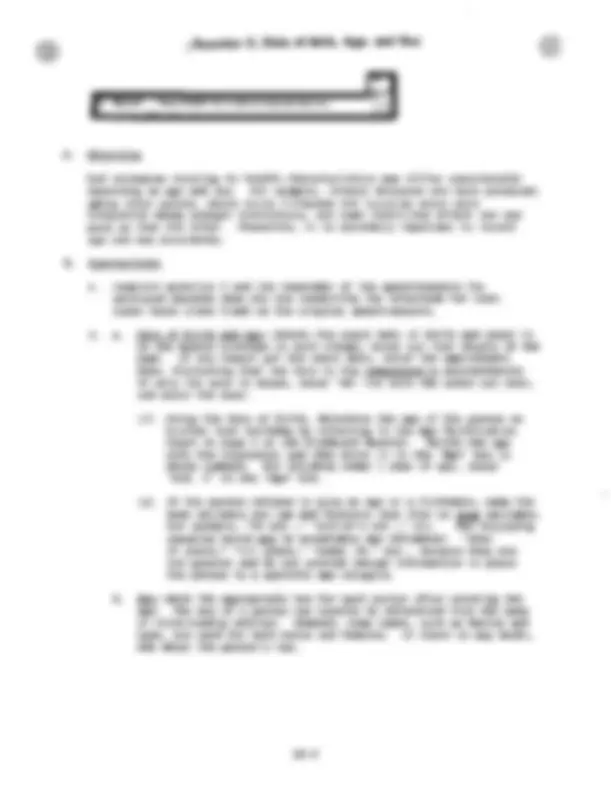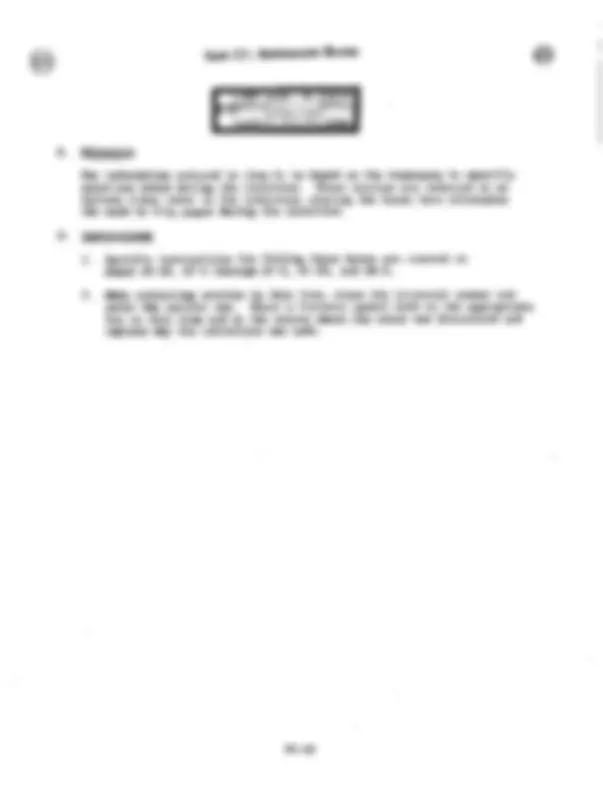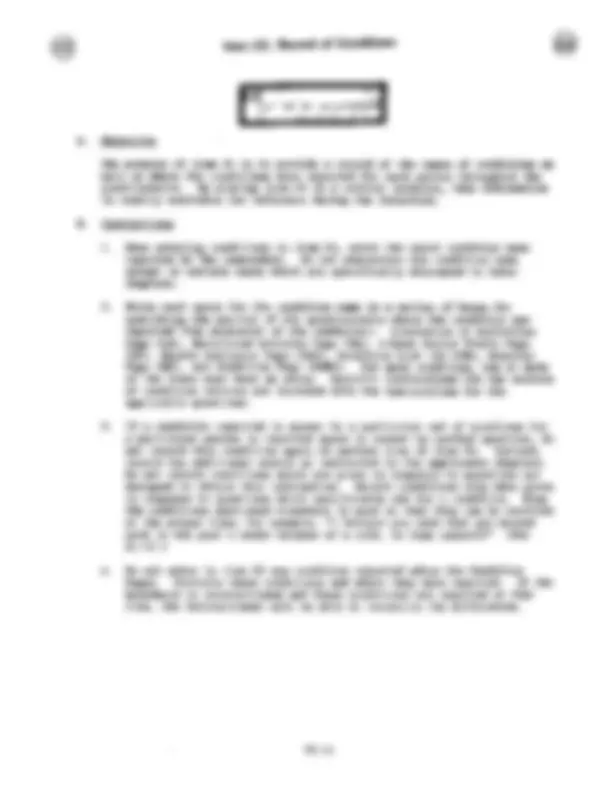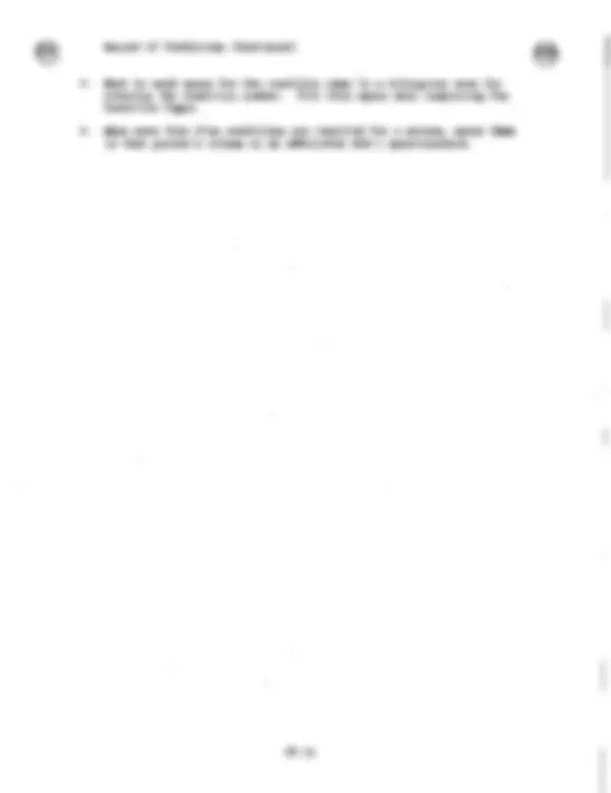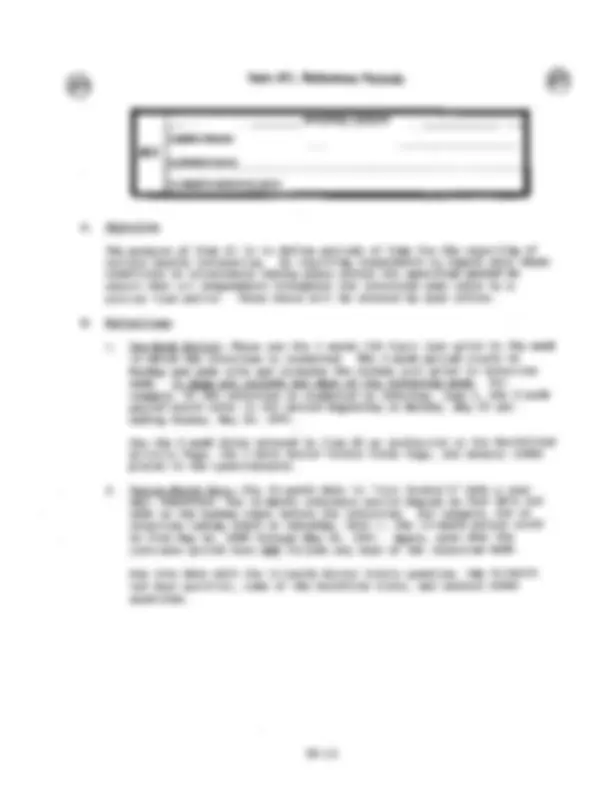Download 1991 National Health Survey Interviewer's Manual and more Study notes Spanish Culture in PDF only on Docsity!
~ ~
Public U s e
D a t a Taloe
Documentation
~ ~
Part I 1 - Field Representative'sManual, HIS-
National Health Interview Survey, 1991
From the CENTERS FOR DISEASE CONTROL/National Center for Health Statistics
~~
US. DEPARTMENT OF HEALTH AND HUMAN SERVICES Public HealthService
Centers for Disease Control CDC
National Center for Health Statistics CENERS FOA DISEASE CONTROL
Public U s e
Part II - Field Representative'sManual, HIS-
National Health Interview Survey, 1991
From the CENTERS FOR DISEASE CONTROL National Center for Health Statistics
US. DEPARTMENT OF HEALTH AND HUMAN SERVICES Public Health Service Centers for Disease Control NationalCenter for Health Statistics
Hyattsville, Maryland November 1992
i
Page
- Quality of interviewing .................................... A2-
a. Your accuracy rate ..................................... A2-
b. Field evaluation of your work .......................... A2- 3. Performance rating ......................................... A2-
\
ii
CHAPTER 1. DESCRIPTION OF THE SURVEY
A. Purpdse of the
National Health
Interview Survey
1. General ' The basic purpose of the National Health
Interview Survey is to obtain information
about the amount and distribution of illness.,
its effects in terms of disability and chronic
impairments, and the kind of health services
people receive.
The National Health Interview Survey is part
of the National Health Survey, which began in
May 1957. Prior to that time, the last
nationwide survey of health had been
conducted in 1935-36. Wany developments
affecting 'the national health had taken place
,in the intervening years:
The Nation went €rom depression to
prosperity and through two wars.
"Wonder drugs" such as penicillin were
discovered and put into use.
Public and private health programs were
enlarged.
Hospitalization and other health
insurance plans broadened their coverage
to protect many more people.
Increased research programs were
providing information leading to the
cure, control, or prevention of such
major diseases as heart disease, cancer,
tuberculosis, muscular dystrophy, and
polio through the development of products
like the Salk Polio Vaccine.
0
e
c. Control of acc ident s
d. Health of the aged
e. Health education and research
Today, chronic illness and disability among .both adults and children, constitute our greatest public health challenge. Chronic illness and disability lower the earning power, living standards, and the general well- being of individuals and families. They
redUce the Nation's potential output of goods
and services and, in advanced stages, burden individuals, families, and communities with the high cost of care and assistance. The basic public health principle to be applied is the same: Prevention. Better information. on the occurrence and severity of diseases and disability are needed in order to prevent their occurrence.
Programs for the effective control of accidents are still in their infancy. Statistics on the cause and frequency of nonfatal as well as fatal accidents of various types help to shape accident prevention programs and measure their success.
There is a nationwide interest in prolonging the effective working life of the aged and aging. Knowledge of the health status of people in their middle and later years is essential to effective community planning for the health, general welfare, and continued activity of older persons.
Governmental health programs have their
counterparts in many of the national and local
voluntary associations and organizations. These associations collect many millions of dollars annually to promote research and education in such fields as polio-myelitis, cancer, lung disease, heart disease, mental health, crippling conditions, multiple,, sclerosis, alcoholism, and so on.
Before Congress authorized the continuing National Health Survey, these organizations had to rely on mortality statistics almost exclusively as a source of information about the disease or condition with which they are principally concerned. Current health statistics produced by the National Health Survey aid such groups greatly in planning their activities and expenditures.
A1-
f. Health
facilities--
hosp i ta
care , rehabili tat i,on, insurance, etc.
g. Factors
related to
various
diseases
3. Who uses the
data
B. Sponsorship of
the Survey
The growth of prepayment coverage under
voluntary health insurance has increased the
demand for the kind of illness statistics
which can provide reliable estimates of the
number of people who will be ill for a given
number of weeks or months. Illness statistics
provide an improved measurement of the need
for hospitals and other health facilities and
assist in planning for their more effective
distribution. Public school authorities are
aided in their planning for the special
educational problems of mentally retarded or
physically handicapped children. Vocational
rehabilitation programs, public officials and
industries concerned with manpower problems
and industrial safety health measures, the
insurance industry, the pharmaceutical and
appliance manufacturers are also greatly
assisted by reliable statistics on illness and
disability.
Furthermore, statistical information of this
kind is an additional tool for medical
research. A study of data showing this
relationship between certain economic,
geographic, or other factors and the various
diseases indicates new avenues of exploration
and suggest hypotheses for more precise
testing.
The principal users of the data are the U.S.
Public Health Service, state and local health
departments, public and private welfare
agencies, medical schools, medical research
organizations, and corporations engaged in the
manufacture of drugs and medical supplies.
Many other organizations and individuals also
use the data.
The National Health Survey is sponsored by the
National Center for Health Statistics which is
part of the U.S. Public Health Service.
Because of the Bureau's broad experience in
conducting surveys, we conduct much of the
interviewing for the Public Health Service.
The findings of the survey are analyzed and
published regularly by the Public Health
Service.
The National Health Survey is not a single
survey but a continuing program of surveys
which includes the^ following:
A 1 4
2. Sample EDs and
segments
3. Sample units
4. Sample of newly
constructed
units
5. Sample of
special
places
c. From each group, one or a set of
counties is selected to represent all
of the counties in the group. The
selected counties (or sets of
counties) are called primary sampling
units, which we abbreviate to PSU.
There are 201 PSUs in the HIS sample.
Within each PSU:
a. A sample of Census Enumeration
Districts (EDs) is selected.
b. Each selected ED is divided into
either small land areas or groups of
addresses. These land areas and
groups of addresses are called
segments.
c. Each segment contains addresses which
are assigned for interview in one or
more samples. Two types of sewents,
Area and Block, are land area
segments, the third type of segment,
Permit, is a sample of new
construction addresses. (See
paragraph 4, below.)
Depending on the type of segment, you will
either interview at units already designated
on a listing sheet, or you will list the units
at a specific address and interview those on
designated lines of the listing sheet. In
either case it is a sample of addresses, not
persons or families.
In areas where building permits are issued for
new construction (Permit Areas), we select a
sample of building permits issued since the
1980 Decennial Census. These addresses are
assigned as Permit segments.
In places where no building permits are
required (Non-Permit Areas), newly constructed
units are listed and, if in sample,
interviewed in Area Segments only. In
Non-Permit Areas, only Area segments are
assigned. In these segments, units built
after .4/1/80 are eligible for interview since
they are not selected in the permit universe.
Some sample units are located in places with
special living arrangements, such as dormi-
tories, institutions, convents, or mobile home
parks. These type of living quarters are
classified as special places. Units in
special places are listed and interviewed in
Area and Block segments.
A1-
6. The quarterly
sample
,For purposes of quarterly tabulations of data,
separate samples are designated for each
quarter of the year. Each quarterly sample
is then distributed into 13 weekly samples, of
approximately equal size, so that any seasonal
factors will not distort the survey results.
The sample designation identifies the calendar
year and quarter in which sample units are
interviewed. For^ example,^ 9 5 1^ designates the
sample beginning in January 1995, 952
designates the sample beginning in April 1995,
etc.
D. Scope of the survey Each year, health information is gathered for
every civilian person in about 50,000 sample
households. Adult residents, found at home
at the time of your call, provide the
information required.
The HIS-1 questionnaire for the survey
provides for certain information to be
collected on a continuing basis.
to this basic information, supplemental
inquiries are added from time to time in
order to provide information on special
topics. Any one special topic inquiry may be
repeated at regular intervals, or^ may be used
only once.
In addition
E. Information accorded
confidential treatment
All information which would permit identifi-
cation of the individual is held strictly
confidential, seen only by persons engaged in
the National Health Interview Survey
(including related studies carried out by the
Public Health Service) and not disclosed or
released to others for any other purpose
without the written consent of the
individual.
this manual for a thorough discussion of
confidentiality.)
(See Appendix A to part E of
A1-
D. Standards of performance for Field Representatives
- Production standards
a. Planning; your travel route
The National Health Interview Survey is operated on a fixed budget which means that every phase of the survey must be conducted in the most efficient way. Otherwise, it will be impossible
to conduct the survey or to continue the employ-
men't of the persons assigned to it.
The success of HIS depends on each Field Representative getting and recording accurate and complete information. Otherwise, no amount of review or correction can improve the reliability of the results. Equally important, if you do not complete your assignments efficiently in the prescribed time period, the survey cannot be conducted within its time schedule or its budget.
Standards of performance have been established so that each Field Representative will know what is required.
We have determined the amount of time (based on past experience of HIS Field Representatives) required to complete each assignment accurately at a reasonable working pace. This standard, which includes time for travel, listing, interviewing, and other required activities, will be compared with the amount of time you actually take for the assignment, to see how efficiently you.are performing your work.
Always begin on Monday of "interview" week and complete your interviews as soon as possible during that week. Completion of your assignment within the specified time is not only important from a cost standpoint, but is also essential in order to meet production deadlines.
The time and mileage spent in traveling from one
segment to the next is one of the major costs of
the survey.. Hold travel t o a minimum by carefully planning which segments t o visit on a particular day and the order in which to visit them.
A2-
b. Reduction
of
cat1backs
Costs and timing are also affected by the number
of callbacks (revisits to an address) required.
You may find that your rate of production is
relatively high during the first few days of
interviewing because somebody is at home at most
of the addresses you visit. However, production
may fall off if you have scattered callbacks.
You can minimize this by planning your initial
visits at the most productive time, and by tying
in callbacks with remaining initial visits to
the same part of the sample area.
Where a household is not at home during your
first visit, make a careful inquiry of.
neighbors, janitors, etc., to find out when
would be the best time to call.
c. Efficient Another time saver is the efficient conduct of
conduct of
interviews
interviews. If you are thoroughly familiar with
the sequen.ce of items on the HIS-1 question-
naires, and how to fill each one, you can
conduct a rapid and efficient interview without
sacrificing accuracy.
briefly and clearly, the purpose of the survey,
how the information is used, and related
Be prepared to explain,
subjects.
publications which you can show the respondent
You will be given copies of
to help you in your explanation. You should
also save any articles from local newspapers or
magazines that report results of Census survey
work in association with the National Center
for Health Statistics.
2. Quality of
interviewing.
No matter how efficiently the survey is
conducted, the results may be seriously affected
by incomplete, or inaccurately filled, listing
and interview forms. In rating Field
Representatives, the quality of their work is
given as much weight as their productivity.
This manual, and other materials which will be
provided, contain all of the instructions
needed to list and interview. Learn how to use
the manual to look up unfamiliar things. Also,
learn how to use the INTERviewer COMnunication
to advise your office of special situations or
problems.
A2-
HIS- 1991
0
PART D
HOW TO CONDUCT THK HIS IBJTKRVIEU
TABLE OF CONTENTS
PART D
- Who May Respond to Questions on tte Household Page
Check Item B3 and Question 8, Major Activity. '.. ..
. -
- HIS-
- CHAPTER 1 INTERVIEW FORMS D1- HOW TO CONDUCT THE HIS INTERVIEW
- A Description of the HIS-1 Questionnaire D1-
- B Description of the HIS-1 Supplement Booklets D1-
- C Format of the HIS-1 Questionnaires D1-
- D Field Representative's Flashcard Booklet Form HIS-501 D1-
- E Use of the Spanish Translation Guides D1-
- F Xalendar Card D1-
- CHAPTER 2 GENERAL INSTRUCTIONS FOR USING THE HIS QUESTIONNAIRES D2- - A Types of Questions D2- - 1 Family-Style D2- << - 2 Individual-Style D2- - B Symbols and Print Type D2- - C Skip Instructions D2- - D How to Hake Entries D2- - E Questions Which Are Reasked ; D2- - F Corrections D2-
- G More Than One HIS-1 Questionnaire D2-
- H Events Starting During the Interview Week D2-
- I Footnotes and Comments D2-
- J Computing Answers D2-
- K Flashcards D2-
- L Conducting the Interview D2-
- M Sample Selection Labels D2-
- CHAPTER 3.. S ESPONDENT RULES D3- - A Overall Objective D3- - B General Definitions D3- - C General Instructions D3- - all persons living in the unit) D3- and to Questions 1 and 2 (Name and relationship of - ("Eligible" Respondent) D3- 2 Who Hay Respond to the Remaining HIS-1 Questions - 3 Return Visit Hay Be Necessary D3-
- CHAPTER 4 HOUSEHOLD PAGE D4-
- Overall Objective D4-
- Item 1 Book of Books D4- - Instructions D4-
- Items 2 through 5 Identification D4- - A Objective D4- - B Instructions D4-
- Question 6. Address D4- - A Objective D4- - B Instructions D4-
- Question 7. Year Built D4- - A Objective D4- - B Definition D4- - C. Instructions D4-
- Question 8. .Coverage .: D4- - A Objective D4- - B Instructions D4-
- Item 9 Land Use D4- - A Objective D4- - B Definitions D4- - C Instructions D4-
- Item 10. Classification of Living mar-ters D4- - A Objective D4- - B Definitions D4- - C. Instructions D4-
- Question 11. Telephone Number D4- - A Objective D4- - B Instructions D4-
- Name and Code and Language of Interview D4- Items 12 and 13. Interview Observed. Interviewer's - Instructions D4-
- Item 14. Noninterview Reason D4- - A Objective D4- - B Definition D4- - C Instructions D4-
- Item 15. Record of Calls D4- - A Definitions D4- - B Instructions D4-
- Items 16 and 17. Record of Callbacks D4- - A Objective D4- - B Instructions D4-
- CHAPTER 5 HOUSEHOLD COMPOSITION PAGE D5-
- Overall Objective D5- - Question 1. Household Composition D5- - A Objective D5- - B Definitions D5- - C Instructions D5- - Question 2 Relationship D5- - A Objective D5- - B Instructions D5-
- Question 3. Date of Birth. Age. and Sex d5- - A Objective D5- - B Instructions D5-
- Item C1. Reference Boxes in C1 D5- - A Objective D5- - B Instructions D5-
- Item C2. Record of Conditions D5- - A Objective D5- - B Instructions D5-
- Item Al. Reference Perio.ds D5- - A Objective D5- - B Definitions............................................ D5- - C Instructions 05- - A Objective D5- Item A2. Condition List D5-15 h - B Instructions D5-
- Check Item A3 D5- - Instructions 05-
- Question 4. In Armed Forces D5- - A Objective D5- - B Definition D5- - C Instructions 05-
- Item 5. Additional Respondent Probe d5- - A Objective D5- - B Instructions 05-
- Introductory Statement 05- - Instructions 05-
- Question 6. Hospital Probe 05- - A Objective D5- - B Definitions D5- - C Instructions D5-
- Question 7. Hospitalizations for.Births D5- - A Objective 05- - B Instructions D5-
- CHAPTER 6. LIMITATION OF ACTIVITY PAGES D6-
- A. Overall Objective _ I D6-
- B. General Definitions D6-
- C. General Instructions _ L I ' D6- - Check Item B1 D6- - Instructions D6- - Question 1, Major Activity in Past'l2 Months-......... .:.. D6- - A. Objective D6- - B. Definitions D6- - C. Instructions i D6- - Question 2, Limitation in Job or Business D6 - Instructions D6- - Question 3, Limitation in Housework _ D6- - A. Definition D6- - B. Instructions D6- - Question 4, Condition Causing Limitation in Housework D6- - A. Definitions D6- - B. Instructions D6- - Question 5 , Would the Person be Limited in, Work_ .....:. D6- - Objective D6- - Check Item B2 and Question 6, Other Limitations ~. _ _ D6- - A 'Objective .......:. > _ _ _ I - D6- - B. Definition - -D6- - C. Instructions D6- , , - - -- - School, or Other Activities ;..;.;-.....; D6- Question-7;Condition Causing LimitaEion'in.~ Work, ' - ' - Instructions ~ D6- - in Past 12 .Months i D6- - _. ' - A. Definitions , ; _ D6- - B;. Instructions - -. D6- - Question 9 , Limitation in Daily Functions - - ;. D6- - A. 'Objective b ; ; - .-D6- - B. Definitions _ I _ - D6- - C. Instructions .~ ' D6- - D6- Question 10, Limitation in Play'Activities - Instructions _ D6- * ' - Question 11, Limited in School'.................................. D6- - A. Definitions ..............'.........................:... D6- - B. Instructions D6-
- Question.12,Limited in Any Way ..; D6- - A. Definition D6- - B. Instructions D6- - Question 13, Condition Causing Limitation D6- - Instructions D6- - Check Item B4 D6- - Instructions D6- - Check Item B5 D6- - Instructions D6-

